In Search of a Green Process: Polymeric Films with Ordered Arrays via a Water Droplet Technique
Abstract
1. Introduction
2. Materials
2.1. Amphiphilic Polymers for Honeycomb-Like Films
2.2. Surfactant-Facilitated BF Process for Honeycomb-Like Films
2.3. Crosslinkable Materials for Honeycomb-Like Films
3. Applications
Applications of Polymeric Ordered Arrays
4. Towards a Greener Process
4.1. Investigation of Water Droplet Nucleation
4.2. The Concept of Green Solvents
4.3. Greener Solvents for the BF Process
4.3.1. Use of Less Hazardous Solvents (Toluene, THF, Acetone, Acetonitrile, EA, and MEK)
4.3.2. Stabilizing Water Droplets with Surfactants and Colloidal Particles
4.4. Unique Techniques for Ordered Arrays
5. Summary and Future Prospects
Author Contributions
Funding
Conflicts of Interest
References
- Aitken, J. Breath Figures. Nature 1911, 86, 516–517. [Google Scholar] [CrossRef]
- Rayleigh, L. Breath Figures. Nature 1911, 86, 416–417. [Google Scholar] [CrossRef]
- Widawski, G.; Rawiso, M.; Franois, B. Self-Organized Honeycomb Morphology of Star-Polymer Polystyrene Films. Nature 1994, 369, 387–389. [Google Scholar] [CrossRef]
- Dou, Y.; Jin, M.; Zhou, G.; Shui, L. Breath Figure Method for Construction of Honeycomb Films. Membranes 2015, 5, 399–424. [Google Scholar] [CrossRef] [PubMed]
- Bormashenko, E. Breath-Figure Self-Assembly, a Versatile Method of Manufacturing Membranes and Porous Structures: Physical, Chemical and Technological Aspects. Membranes 2017, 7, 45. [Google Scholar] [CrossRef] [PubMed]
- Kralisch, D.; Ott, D.; Gericke, D. Rules and Benefits of Life Cycle Assessment in Green Chemical Process and Synthesis Design: A Tutorial Review. Green Chem. 2015, 17, 123–145. [Google Scholar] [CrossRef]
- Cui, Y.; Yao, H.; Zhang, J.; Zhang, T.; Wang, Y.; Hong, L.; Xian, K.; Xu, B.; Zhang, S.; Peng, J.; et al. Over 16% Efficiency Organic Photovoltaic Cells Enabled by a Chlorinated Acceptor with Increased Open-Circuit Voltages. Nat. Commun. 2019, 10, 2515. [Google Scholar] [CrossRef]
- Zhao, W.; Li, S.; Yao, H.; Zhang, S.; Zhang, Y.; Yang, B.; Hou, J. Molecular Optimization Enables over 13% Efficiency in Organic Solar Cells. J. Am. Chem. Soc. 2017, 139, 7148–7151. [Google Scholar] [CrossRef]
- Bai, H.; Du, C.; Zhang, A.; Li, L. Breath Figure Arrays: Unconventional Fabrications, Functionalizations, and Applications. Angew Chem. Int. Ed. Engl. 2013, 52, 12240–12255. [Google Scholar] [CrossRef]
- Bormashenko, E.; Frenkel, M.; Vilk, A.; Legchenkova, I.; Fedorets, A.; Aktaev, N.; Dombrovsky, L.; Nosonovsky, M. Characterization of Self-Assembled 2D Patterns with Voronoi Entropy. Entropy 2018, 20, 956. [Google Scholar] [CrossRef]
- Escalé, P.; Rubatat, L.; Billon, L.; Save, M. Recent Advances in Honeycomb-Structured Porous Polymer Films Prepared via Breath Figures. Eur. Polym. J. 2012, 48, 1001–1025. [Google Scholar] [CrossRef]
- Heng, L.; Wang, B.; Li, M.; Zhang, Y.; Jiang, L. Advances in Fabrication Materials of Honeycomb Structure Films by the Breath-Figure Method. Materials 2013, 6, 460–482. [Google Scholar] [CrossRef] [PubMed]
- Hernández-Guerrero, M.; Stenzel, M.H. Honeycomb Structured Polymer Films via Breath Figures. Polym. Chem. 2012, 3, 563–577. [Google Scholar] [CrossRef]
- Zhang, A.; Bai, H.; Li, L. Breath Figure: A Nature-Inspired Preparation Method for Ordered Porous Films. Chem. Rev. 2015, 115, 9801–9868. [Google Scholar] [CrossRef] [PubMed]
- Zhang, Q.; Yang, X.; Li, P.; Huang, G.; Feng, S.; Shen, C.; Han, B.; Zhang, X.; Jin, F.; Xu, F.; et al. Bioinspired Engineering of Honeycomb Structure-Using Nature to Inspire Human Innovation. Prog. Mater. Sci. 2015, 74, 332–400. [Google Scholar] [CrossRef]
- Yabu, H. Fabrication of Honeycomb Films by the Breath Figure Technique and Their Applications. Sci. Technol. Adv. Mater. 2018, 19, 802–822. [Google Scholar] [CrossRef]
- Wu, B.-H.; Zhu, L.-W.; Ou, Y.; Tang, W.; Wan, L.-S.; Xu, Z.-K. Systematic Investigation on the Formation of Honeycomb-Patterned Porous Films from Amphiphilic Block Copolymers. J. Phys. Chem. C 2015, 119, 1971–1979. [Google Scholar] [CrossRef]
- Yuan, H.; Yu, B.; Cong, H.; Chi, M.; Cheng, Y.; Lv, C. Preparation of Hierarchical Highly Ordered Porous Films of Brominated Poly(phenylene oxide) and Hydrophilic SiO2/C Membrane via the Breath Figure Method. Materials 2018, 11, 481. [Google Scholar] [CrossRef] [PubMed]
- Liu, X.; Monzavi, T.; Gitsov, I. Controlled ATRP Synthesis of Novel Linear-Dendritic Block Copolymers and Their Directed Self-Assembly in Breath Figure Arrays. Polymers 2019, 11, 539. [Google Scholar] [CrossRef]
- Ji, E.; Pellerin, V.; Ehrenfeld, F.; Laffore, A.; Bousquet, A.; Billon, L. Hierarchical Honeycomb-Structured Films by Directed Self-Assembly in “Breath Figure” Templating of Ionizable “Clicked” PH3T-b-PMMA Diblock Copolymers: An Ionic Group/Counter-Ion Effect on Porous Polymer Film morphology. Chem. Commun. 2017, 53, 1876–1879. [Google Scholar] [CrossRef]
- De León, A.S.; Muñoz-Bonilla, A.; Fernández-García, M.; Rodríguez-Hernández, J. Breath Figures Method to Control the Topography and the Functionality of Polymeric Surfaces in Porous Films and Microspheres. J. Polym. Sci. Polym. Chem. 2012, 50, 851–859. [Google Scholar] [CrossRef]
- Chen, A.; Blakey, I.; Whittaker, A.K.; Peng, H. The Influence of Casting Parameters on the Surface Morphology of PS-b-P4VP Honeycomb Films. J. Polym. Sci. Polym. Chem. 2016, 54, 3721–3732. [Google Scholar] [CrossRef]
- Dong, W.; Zhou, Y.; Yan, D.; Mai, Y.; He, L.; Jin, C. Honeycomb-Structured Microporous Films Made from Hyperbranched Polymers by the Breath Figure Method. Langmuir 2009, 25, 173–178. [Google Scholar] [CrossRef] [PubMed]
- Zhang, S.; Xu, T.; Chai, S.; Zhang, L.; Wu, L.; Li, H. Supramolecular Star Polymer Films with Tunable Honeycomb Structures Templated by Breath Figures. Polymer 2017, 117, 306–314. [Google Scholar] [CrossRef]
- Chang, C.-C.; Juang, T.-Y.; Ting, W.-H.; Lin, M.-S.; Yeh, C.-M.; Dai, S.A.; Suen, S.-Y.; Liu, Y.-L.; Jeng, R.-J. Using a Breath-Fgure Method to Self-Organize Honeycomb-Like Polymeric Films from Dendritic Side-Chain Polymers. Mater. Chem. Phys. 2011, 128, 157–165. [Google Scholar] [CrossRef]
- Su, Y.-A.; Chen, W.-F.; Juang, T.-Y.; Ting, W.-H.; Liu, T.-Y.; Hsieh, C.-F.; Dai, S.A.; Jeng, R.-J. Honeycomb-Like Polymeric Films from Dendritic Polymers Presenting Reactive Pendent Moieties. Polymer 2014, 55, 1481–1490. [Google Scholar] [CrossRef]
- Ting, W.-H.; Chen, C.-C.; Dai, S.A.; Suen, S.-Y.; Yang, I.K.; Liu, Y.-L.; Chen, F.M.C.; Jeng, R.-J. Superhydrophobic Waxy-Dendron-Grafted Polymer Films via Nanostructure Manipulation. J. Mater. Chem. 2009, 19. [Google Scholar] [CrossRef]
- Wu, C.-H.; Ting, W.-H.; Lai, Y.-W.; Dai, S.A.; Su, W.-C.; Tung, S.-H.; Jeng, R.-J. Tailored Honeycomb-Like Polymeric Films Based on Amphiphilic Poly(urea/malonamide) Dendrons. RSC Adv. 2016, 6, 91981–91990. [Google Scholar] [CrossRef]
- Wu, C.-H.; Lu, C.-S.; Chen, W.-L.; Tung, S.-H.; Jeng, R.-J. Honeycomb Surface with Shape Memory Behavior Fabricated via Breath Figure Process. Macromol. Mater. Eng. 2018, 303. [Google Scholar] [CrossRef]
- Yu, Y.; Ma, Y. Breath Figure Fabrication of Honeycomb Films with Small Molecules Through Hydrogen Bond Mediated Self-Assembly. Soft Matter 2011, 7. [Google Scholar] [CrossRef]
- Park, J.S.; Lee, S.H.; Han, T.H.; Kim, S.O. Hierarchically Ordered Polymer Films by Templated Organization of Aqueous Droplets. Adv. Funt. Mater. 2007, 17, 2315–2320. [Google Scholar] [CrossRef]
- Jiang, X.; Zhang, T.; Xu, L.; Wang, C.; Zhou, X.; Gu, N. Surfactant-Induced Formation of Honeycomb Pattern on Micropipette with Curvature Gradient. Langmuir 2011, 27, 5410–5419. [Google Scholar] [CrossRef] [PubMed]
- Zhang, L.; Chen, L.; Liu, S.X.; Gong, J.; Tang, Q.; Su, Z.M. Honeycomb-Patterned Hybrid Films of Surfactant-Encapsulated Polyoxometalates by a Breath Figure Method and Its Electrocatalysis for BrO3−. Dalton Trans. 2017, 47, 105–111. [Google Scholar] [CrossRef] [PubMed]
- Wang, J.; Wang, C.F.; Shen, H.X.; Chen, S. Quantum-Dot-Embedded Ionomer-Derived Films with Ordered Honeycomb Structures via Breath Figures. Chem. Commun. 2010, 46, 7376–7378. [Google Scholar] [CrossRef] [PubMed]
- Yin, S.; Goldovsky, Y.; Herzberg, M.; Liu, L.; Sun, H.; Zhang, Y.; Meng, F.; Cao, X.; Sun, D.D.; Chen, H.; et al. Functional Free-Standing Graphene Honeycomb Films. Adv. Funct. Mater. 2013, 23, 2972–2978. [Google Scholar] [CrossRef]
- Lim, B.K.; Lee, S.H.; Park, J.S.; Kim, S.O. Water-Repellent Macroporous Carbon Nanotube/Elastomer Nanocomposites by Self-Organized Aqueous Droplets. Macromol. Res. 2009, 17, 666–671. [Google Scholar] [CrossRef]
- Sun, W.; Shao, Z.; Ji, J. Particle-Assisted Fabrication of Honeycomb-Structured Hybrid Films via Breath Figures Method. Polymer 2010, 51, 4169–4175. [Google Scholar] [CrossRef]
- Sun, W.; Zhou, Y.; Chen, Z. Fabrication of Honeycomb-Structured Porous Film from Polystyrene via Polymeric Particle-Assisted Breath Figures Method. Macromol. Res. 2012, 21, 414–418. [Google Scholar] [CrossRef]
- Tu, Z.; Tang, H.; Shen, X. Particle-Assisted Semidirect Breath Figure Method: A Facile Way to Endow the Honeycomb-structured Petri Dish with Molecular Recognition Capability. ACS Appl. Mater. Interfaces 2014, 6, 12931–12938. [Google Scholar] [CrossRef]
- Sun, W.; Ji, J.; Shen, J. Rings of Nanoparticle-Decorated Honeycomb-Structured Polymeric Film: The Combination of Pickering Emulsions and Capillary Flow in the Breath Figures Method. Langmuir 2008, 24, 11338–11341. [Google Scholar] [CrossRef]
- Yaakov, N.; Ananth Mani, K.; Felfbaum, R.; Lahat, M.; Da Costa, N.; Belausov, E.; Ment, D.; Mechrez, G. Single Cell Encapsulation via Pickering Emulsion for Biopesticide Applications. ACS Omega 2018, 3, 14294–14301. [Google Scholar] [CrossRef] [PubMed]
- Yin, G.; Zheng, Z.; Wang, H.; Du, Q.; Zhang, H. Preparation of Gaphene Oxide Coated Polystyrene Microspheres by Pickering Emulsion Polymerization. J. Colloid Interface Sci. 2013, 394, 192–198. [Google Scholar] [CrossRef] [PubMed]
- Wu, X.; Wang, S. Integration of Photo-Crosslinking and Breath Figures to Fabricate Biodegradable Polymer Substrates with Tunable Pores that Regulate Cellular Behavior. Polymer 2014, 55, 1756–1762. [Google Scholar] [CrossRef]
- Zhu, L.-W.; Yang, W.; Ou, Y.; Wan, L.-S.; Xu, Z.-K. Synthesis of Polystyrene with Cyclic, Ionized and Neutralized End Groups and the Self-Assemblies Templated by Breath Figures. Polym. Chem. 2014, 5, 3666–3672. [Google Scholar] [CrossRef]
- Connal, L.A.; Vestberg, R.; Hawker, C.J.; Qiao, G.G. Dramatic Morphology Control in the Fabrication of Porous Polymer Films. Adv. Funct. Mater. 2008, 18, 3706–3714. [Google Scholar] [CrossRef]
- Shau, S.-M.; Juang, T.-Y.; Lin, H.-S.; Huang, C.-L.; Hsieh, C.-F.; Wu, J.-Y.; Jeng, R.-J. Individual Graphene Oxide Platelets through Direct Molecular Exfoliation with Globular Amphiphilic Hyperbranched Polymers. Polym. Chem. 2012, 3, 1249–1259. [Google Scholar] [CrossRef]
- Shau, S.-M.; Chang, C.-C.; Lo, C.-H.; Chen, Y.-C.; Juang, T.-Y.; Dai, S.A.; Lee, R.-H.; Jeng, R.-J. Organic/Metallic Nanohybrids Based on Amphiphilic Dumbbell-Shaped Dendrimers. ACS Appl. Mater. Interfaces 2012, 4, 1897–1908. [Google Scholar] [CrossRef]
- Wu, C.-H.; Chen, Y.-C.; Dai, S.A.; Chen, S.-C.; Tung, S.-H.; Lee, R.-H.; Su, W.-C.; Jeng, R.-J. Iterative Synthesis of Monodisperse Pendants for Making Comb-Like Polyurethanes. Polymer 2017, 119, 1–12. [Google Scholar] [CrossRef]
- Chiang, C.-Y.; Liu, T.-Y.; Su, Y.-A.; Wu, C.-H.; Cheng, Y.-W.; Cheng, H.-W.; Jeng, R.-J. Au Nanoparticles Immobilized on Honeycomb-Like Polymeric Films for Surface-Enhanced Raman Scattering (SERS) Detection. Polymers 2017, 9, 93. [Google Scholar] [CrossRef]
- Tsai, C.-C.; Juang, T.-Y.; Dai, S.A.; Wu, T.-M.; Su, W.-C.; Liu, Y.-L.; Jeng, R.-J. Synthesis and Montmorillonite-Intercalated Behavior of Dendritic Surfactants. J. Mater. Chem. 2006, 16, 2056–2063. [Google Scholar] [CrossRef]
- Dai, S.A.; Juang, T.-Y.; Chen, C.-P.; Chang, H.-Y.; Kuo, W.-J.; Su, W.-C.; Jeng, R.-J. Synthesis of N-aryl Azetidine-2,4-Diones and Polymalonamides Prepared from Selective Ring-Opening Reactions. J. Appl. Polym. Sci. 2007, 103, 3591–3599. [Google Scholar] [CrossRef]
- Chen, Y.-C.; Juang, T.-Y.; Dai, S.A.; Wu, T.-M.; Lin, J.-J.; Jeng, R.-J. Optical Non-Linearity from Montmorillonite Intercalated with a Chromophore-Containing Dendritic Structure: A Self-Assembly Approach. Macromol. Rapid Comm. 2008, 29, 587–592. [Google Scholar] [CrossRef]
- Chen, Y.-C.; Juang, T.-Y.; Wu, T.-M.; Dai, S.A.; Kuo, W.-J.; Liu, Y.-L.; Chen, F.-M.; Jeng, R.-J. Orderly Arranged NLO Materials Based on Chromophore-Containing Dendrons on Exfoliated Layered Templates. ACS Appl. Mater. Interfaces 2009, 1, 2371–2381. [Google Scholar] [CrossRef] [PubMed]
- Tsai, C.-C.; Chao, T.-Y.; Lin, H.-L.; Liu, Y.-H.; Chang, H.-L.; Liu, Y.-L.; Jeng, R.-J. The Facile Synthesis and Optical Nonlinearity of Hyperbranched Polyaspartimides with Azobenzene Dyes. Dyes and Pig. 2009, 82, 31–39. [Google Scholar] [CrossRef]
- Lin, H.-L.; Chang, H.-L.; Juang, T.-Y.; Lee, R.-H.; Dai, S.A.; Liu, Y.-L.; Jeng, R.-J. Nonlinear Optical, Poly(amide-imide)–Clay Nanocomposites Comprising an Azobenzene Moiety Synthesised via Sequential Self-Repetitive Reaction. Dyes Pig. 2009, 82, 76–83. [Google Scholar] [CrossRef]
- Tsai, C.-C.; Chang, C.-C.; Yu, C.-S.; Dai, S.A.; Wu, T.-M.; Su, W.-C.; Chen, C.-N.; Chen, F.M.C.; Jeng, R.-J. Side Chain Dendritic Polyurethanes with Shape-Memory Effect. J. Mater. Chem. 2009, 19, 8484–8494. [Google Scholar] [CrossRef]
- Chen, Y.-C.; Chang, H.-L.; Lee, R.-H.; Dai, S.A.; Su, W.-C.; Jeng, R.-J. Nonlinear Optical Polyimides Consisting of Chromophore-Containing Dendrons with Site-Isolation Effect. Polym. Adv. Tech. 2009, 20, 493–500. [Google Scholar] [CrossRef]
- Chen, Y.-C.; Wu, W.-Y.; Juang, T.-Y.; Dai, S.A.; Su, W.-C.; Liu, Y.-L.; Lee, R.-H.; Jeng, R.-J. Poly(urethane/malonamide) Dendritic Structures Featuring Blocked/Deblocked Isocyanate Units. Polym. Chem. 2011, 2, 1139–1145. [Google Scholar] [CrossRef]
- Siao, Y.-Y.; Shau, S.-M.; Tsai, W.-H.; Chen, Y.-C.; Wu, T.-H.; Lin, J.-J.; Wu, T.-M.; Lee, R.-H.; Jeng, R.-J. Orderly Arranged NLO Materials on Exfoliated Layered Templates Based on Dendrons with Alternating Moieties at the Periphery. Polym. Chem. 2013, 4, 2747–2759. [Google Scholar] [CrossRef]
- Hsu, Y.-Y.; Yeh, S.-C.; Lin, S.-H.; Chen, C.-T.; Tung, S.-H.; Jeng, R.-J. Dendrons with Urea/Malonamide Linkages for Gate Insulators of N-channel Organic Thin Film Transistors. React. Funct. Polym. 2016, 108, 86–93. [Google Scholar] [CrossRef]
- Huang, G.-W.; Li, C.-T.; Chen, Y.-C.; Jeng, R.-J.; Dai, S.A. Synthesis and Properties of Polyurea/Malonamide Dendritic Co-Adsorbents for Dye-Sensitized Solar Cells. Polymer 2019, 179, 121673–121681. [Google Scholar] [CrossRef]
- Male, U.; Huh, D.S. Fabrication of Robust Honeycomb Patterned Porous Films by Thermochemical Cross-Linking of Polyimide. Polymer 2019, 178. [Google Scholar] [CrossRef]
- Wan, L.S.; Zhu, L.W.; Ou, Y.; Xu, Z.K. Multiple Interfaces in Self-Assembled Breath Figures. Chem. Commun. 2014, 50, 4024–4039. [Google Scholar] [CrossRef] [PubMed]
- Zhang, Y.; Wang, C. Micropatterning of Proteins on 3D Porous Polymer Film Fabricated by Using the Breath-Figure Method. Adv. Mater. 2007, 19, 913–916. [Google Scholar] [CrossRef]
- Galeotti, F.; Andicsova, A.; Yunus, S.; Botta, C. Precise Surface Patterning of Silk Fibroin Films by Breath Figures. Soft Matter 2012, 8, 4815–4821. [Google Scholar] [CrossRef]
- Hirai, Y.; Yabu, H.; Matsuo, Y.; Ijiro, K.; Shimomura, M. Arrays of Triangular Shaped Pincushions for SERS Substrates Prepared by Using Self-Organization and Vapor Deposition. Chem. Commun. 2010, 46, 2298–2300. [Google Scholar] [CrossRef]
- Fan, Y.; Cheng, H.; Zhou, C.; Xie, X.; Liu, Y.; Dai, L.; Zhang, J.; Qu, L. Honeycomb Architecture of Carbon Quantum Dots: A New Efficient Substrate to Support Gold for Stronger SERS. Nanoscale 2012, 4, 1776–1781. [Google Scholar] [CrossRef]
- Leng, W.; Vikesland, P.J. Nanoclustered Gold Honeycombs for Surface-Enhanced Raman Scattering. Anal. Chem. 2013, 85, 1342–1349. [Google Scholar] [CrossRef]
- Ou, Y.; Wang, L.-Y.; Zhu, L.-W.; Wan, L.-S.; Xu, Z.-K. In-Situ Immobilization of Silver Nanoparticles on Self-Assembled Honeycomb-Patterned Films Enables Surface-Enhanced Raman Scattering (SERS) Substrates. J. Phys. Chem. C 2014, 118, 11478–11484. [Google Scholar] [CrossRef]
- Chen, Y.; Zhang, Y.; Pan, F.; Liu, J.; Wang, K.; Zhang, C.; Cheng, S.; Lu, L.; Zhang, W.; Zhang, Z.; et al. Breath Analysis Based on Surface-Enhanced Raman Scattering Sensors Distinguishes Early and Advanced Gastric Cancer Patients from Healthy Persons. ACS Nano 2016, 10, 8169–8179. [Google Scholar] [CrossRef]
- Tanaka, M.; Takebayashi, M.; Shimomura, M. Fabrication of Ordered Arrays of Biodegradable Polymer Pincushions Using Self-Organized Honeycomb-Patterned Films. Macromol. Symp. 2009, 279, 175–182. [Google Scholar] [CrossRef]
- Tang, H.; Tu, J.-P.; Liu, X.-Y.; Zhang, Y.-J.; Huang, S.; Li, W.-Z.; Wang, X.-l.; Gu, C.-D. Self-Assembly of Si/honeycomb Reduced Graphene Oxide Composite Film as a Binder-Free and Flexible Anode for Li-Ion Batteries. J. Mater. Chem. A 2014, 2, 5834–5840. [Google Scholar] [CrossRef]
- Gong, J.; Xu, B.; Tao, X. Breath Figure Micromolding Approach for Regulating the Microstructures of Polymeric Films for Triboelectric Nanogenerators. ACS Appl. Mater. Interfaces 2017, 9, 4988–4997. [Google Scholar] [CrossRef] [PubMed]
- Han, J.W.; Joo, C.W.; Lee, J.; Lee, D.J.; Kang, J.; Yu, S.; Sung, W.J.; Cho, N.S.; Kim, Y.H. Enhanced Outcoupling in Down-Conversion White Organic Light-Emitting Diodes Using Imprinted Microlens Array Films with Breath Figure Patterns. Sci. Technol. Adv. Mater. 2019, 20, 35–41. [Google Scholar] [CrossRef] [PubMed]
- Zhang, J.; Sun, B.; Huang, X.; Chen, S.; Wang, G. Honeycomb-Like Porous Gel Polymer Electrolyte Membrane for Lithium Ion Batteries with Enhanced Safety. Sci. Rep. 2014, 4, 6007–6013. [Google Scholar] [CrossRef] [PubMed]
- Abbaspour, M.; Pourabbas, B.; Azimi, M.; Abdeali, G.; Asgari, A. Solid-State Supercapacitor Based on Breath Figured Polymethyl Methacrylate Deposited by Graphene: the Effect of Electrode Surface. J. Mater. Sci.-Mater. Electron. 2017, 28, 14121–14130. [Google Scholar] [CrossRef]
- Chiu, Y.-C.; Kuo, C.-C.; Lin, C.-J.; Chen, W.-C. Highly Ordered Luminescent Microporous Films Prepared from Crystalline Conjugated Rod-Coil Diblock Copolymers of PF-b-PSA and Their Superhydrophobic Characteristics. Soft Matter 2011, 7, 9350–9358. [Google Scholar] [CrossRef]
- Miller, S.; Bao, Z. Fabrication of Flexible Pressure Sensors with Microstructured Polydimethylsiloxane Dielectrics Using the Breath Figures Method. J. Mater. Res. 2015, 30, 3584–3594. [Google Scholar] [CrossRef]
- Escale, P.; Rubatat, L.; Derail, C.; Save, M.; Billon, L. pH Sensitive Hierarchically Self-Organized Bioinspired Films. Macromol. Rapid. Commun. 2011, 32, 1072–1076. [Google Scholar] [CrossRef] [PubMed]
- Stenzel, M.H.; Barner-Kowollik, C.; Davis, T.P. Formation of Honeycomb-Structured, Porous Films via Breath Figures with Different Polymer Architectures. J. Polym. Sci. Polym. Chem. 2006, 44, 2363–2375. [Google Scholar] [CrossRef]
- Zhang, J.; Chen, S.; Xie, X.; Kretschmer, K.; Huang, X.; Sun, B.; Wang, G. Porous Poly(vinylidene Fluoride-co-hexafluoropropylene) Polymer Membrane with Sandwich-Like Architecture for Highly Safe Lithium Ion Batteries. J. Membrane Sci. 2014, 472, 133–140. [Google Scholar] [CrossRef]
- Sovizi, M.R.; Fahimi, Z. Honeycomb polyaniline-dodecyl benzene sulfonic acid (hPANI-DBSA)/sulfur as a new cathode for high performance Li–S batteries. J. Taiwan Inst. Chem. E. 2018, 86, 270–280. [Google Scholar] [CrossRef]
- Carlomagno, C.; Speranza, G.; Aswath, P.; Sorarù, G.D.; Migliaresi, C.; Maniglio, D. Breath Figures Decorated Silica-Based Ceramic Surfaces with Tunable Geometry from UV Cross-Linkable Polysiloxane Precursor. J. Eur. Ceram. Soc. 2018, 38, 1320–1326. [Google Scholar] [CrossRef]
- Samanta, S.; Chatterjee, D.P.; Layek, R.K.; Nandi, A.K. Multifunctional Porous Poly(vinylidene fluoride)-graft-Poly(butyl methacrylate) with Good Li+ Ion Conductivity. Macromol. Chem. Phys. 2011, 212, 134–149. [Google Scholar] [CrossRef]
- Song, W.-J.; Park, J.; Kim, D.H.; Bae, S.; Kwak, M.-J.; Shin, M.; Kim, S.; Choi, S.; Jang, J.-H.; Shin, T.J.; et al. Jabuticaba-Inspired Hybrid Carbon Filler/Polymer Electrode for Use in Highly Stretchable Aqueous Li-Ion Batteries. Adv. Energy Mater. 2018, 8, 1702478–1702487. [Google Scholar] [CrossRef]
- Farooqui, U.R.; Ahmad, A.L.; Hamid, N.A. Effect of Polyaniline (PANI) on Poly(vinylidene Fluoride-co-hexaflouro propylene) (PVDF-co-HFP) Polymer Electrolyte Membrane Prepared by Breath Figure Method. Polym. Test. 2017, 60, 124–131. [Google Scholar] [CrossRef]
- Ferrari, E.; Fabbri, P.; Pilati, F. Solvent and Substrate Contributions to the Formation of Breath Figure Patterns in Polystyrene Films. Langmuir 2011, 27, 1874–1881. [Google Scholar] [CrossRef] [PubMed]
- Nishikawa, T.; Ookura, R.; Nishida, J.; Arai, K.; Hayashi, J.; Kurono, N.; Sawadaishi, T.; Hara, M.; Shimomura, M. Fabrication of Honeycomb Film of an Amphiphilic Copolymer at the Air−Water Interface. Langmuir 2002, 18, 5734–5740. [Google Scholar] [CrossRef]
- Bolognesi, A.; Mercogliano, C.; Yunus, S.; Civardi, M.; Comoretto, D.; Turturro, A. Self-Organization of Polystyrenes into Ordered Microstructured Films and Their Replication by Soft Lithography. Langmuir 2005, 21, 3480–3485. [Google Scholar] [CrossRef]
- Heng, L.; Meng, X.; Wang, B.; Jiang, L. Bioinspired Design of Honeycomb Structure Interfaces with Controllable Water Adhesion. Langmuir 2013, 29, 9491–9498. [Google Scholar] [CrossRef]
- Schäfle, C.; Bechinger, C.; Rinn, B.; David, C.; Leiderer, P. Cooperative Evaporation in Ordered Arrays of Volatile Droplets. Phys. Rev. Lett. 1999, 83, 5302–5305. [Google Scholar] [CrossRef]
- Agthe, M.; Wetterskog, E.; Mouzon, J.; Salazar-Alvarez, G.; Bergström, L. Dynamic Growth Modes of Ordered Arrays and Mesocrystals During Drop-Casting of Iron Oxide Nanocubes. Cryst. Eng. Comm. 2014, 16, 1443–1450. [Google Scholar] [CrossRef]
- Thong, A.Z.; Wei Lim, D.S.; Ahsan, A.; Wei Goh, G.T.; Xu, J.; Chin, J.M. Non-Close-Packed Pore Arrays Through One-step Breath Figure Self-Assembly and Reversal. Chem. Sci. 2014, 5, 1375–1382. [Google Scholar] [CrossRef]
- Bao, L.; Rezk, A.R.; Yeo, L.Y.; Zhang, X. Highly Ordered Arrays of Femtoliter Surface Droplets. Small 2015, 11, 4850–4855. [Google Scholar] [CrossRef] [PubMed]
- Zaitsev, D.V.; Kirichenko, D.P.; Shatekova, A.I.; Ajaev, V.S.; Kabov, O.A. Experimental and Theoretical Studies of Ordered Arrays of Microdroplets Levitatingover Liquid and Solide Surfaces. Interfacial Phenom. Heat Transf. 2018, 6, 219–230. [Google Scholar] [CrossRef]
- Bormashenko, E.; Balter, S.; Aurbach, D. On the Nature of the Breath Figures Self-Assembly in Evaporated Polymer Solutions: Revisiting Physical Factors Governing the Patterning. Macromo. Chem. and Phys. 2012, 213, 1742–1747. [Google Scholar] [CrossRef]
- Galeotti, F.; Calabrese, V.; Cavazzini, M.; Quici, S.; Poleunis, C.; Yunus, S.; Bolognesi, A. Self-Functionalizing Polymer Film Surfaces Assisted by Specific Polystyrene End-Tagging. Chem. Mater. 2010, 22, 2764–2769. [Google Scholar] [CrossRef]
- Chen, J.-Z.; Zhao, Q.-L.; Lu, H.-C.; Huang, J.; Cao, S.-K.; Ma, Z. Polymethylene-b-polystyrene Diblock Copolymer: Synthesis, Property, and Application. J. Polym. Sci. Polym. Chem. 2010, 48, 1894–1900. [Google Scholar] [CrossRef]
- Valtola, L.; Karesoja, M.; Tenhu, H.; Ihalainen, P.; Sarfraz, J.; Peltonen, J.; Malinen, M.; Urtti, A.; Hietala, S. Breath Figure Templated Semifluorinated Block Copolymers with Tunable Surface Properties and Binding Capabilities. J. Appl. Polym. Sci. 2015, 132, 41225–41234. [Google Scholar] [CrossRef]
- Prat, D.; Wells, A.; Hayler, J.; Sneddon, H.; McElroy, C.R.; Abou-Shehada, S.; Dunn, P.J. CHEM21 Selection Guide of Classical- and Less Classical-Solvents. Green Chem. 2016, 18, 288–296. [Google Scholar] [CrossRef]
- Capello, C.; Fischer, U.; Hungerbühler, K. What Is a Green Solvent? A Comprehensive Framework for the Environmental Assessment of Solvents. Green Chem. 2007, 9, 927–934. [Google Scholar] [CrossRef]
- Prat, D.; Hayler, J.; Wells, A. A Survey of Solvent Selection Guides. Green Chem. 2014, 16, 4546–4551. [Google Scholar] [CrossRef]
- Byrne, F.P.; Jin, S.; Paggiola, G.; Petchey, T.H.M.; Clark, J.H.; Farmer, T.J.; Hunt, A.J.; Robert McElroy, C.; Sherwood, J. Tools and Techniques for Solvent Selectron: Green Solvent Selection Guides. Sustain. Chem. Process 2016, 4, 7–30. [Google Scholar] [CrossRef]
- Duarte, A.R.; Maniglio, D.; Sousa, N.; Mano, J.F.; Reis, R.L.; Migliaresi, C. From Honeycomb- to Microsphere-Patterned Surfaces of Poly(lactic acid) and a Starch-Poly(lactic acid) Blend via the Breath Figure Method. J. Appl. Biomater. Funct. Mater. 2017, 15, e31–e42. [Google Scholar] [CrossRef] [PubMed]
- Tung, P.-H.; Huang, C.-F.; Chen, S.-C.; Hsu, C.-H.; Chang, F.-C. Regular Honeycomb Porous Polymer Films Based on Amphiphilic Block Copolymer. Desalination 2006, 200, 55–57. [Google Scholar] [CrossRef]
- Sakurai, S.; Furukawa, C.; Okutsu, A.; Miyoshi, A.; Nomura, S. Control of Mesh Pattern of Surface Corrugation via Rate of Solvent Evaporation in Solution Casting of Polymer Film in the Presence of Convection. Polymer 2002, 43, 3359–3364. [Google Scholar] [CrossRef]
- Modigunta, J.K.R.; Male, U.; Huh, D.S. Formylated Polystyrene for the Fabrication of Pore Selective Aldehyde Group Functionalized Honeycomb Patterned Porous Polystyrene Films. J. Polym. Sci. Polym. Phys. 2018, 56, 1181–1192. [Google Scholar] [CrossRef]
- Peng, J.; Han, Y.; Yang, Y.; Li, B. The Influencing Factors on the Macroporous Fomation in Polymer Films by Water Droplet Templating. Polymer 2004, 45, 447–452. [Google Scholar] [CrossRef]
- Park, M.S.; Kim, J.K. Breath Figure Patterns Prepared by Spin Coating in a Dry Environment. Langmuir 2004, 20, 5347–5352. [Google Scholar] [CrossRef]
- Lakshmi, V.; Raju, A.; Resmi, V.G.; Pancrecious, J.K.; Rajan, T.P.D.; Pavithran, C. Amino-Functionalized Breath-Figure Cavities in Polystyrene-Alumina Hybrid Films: Effect of Particle Concentration and Dispersion. Phys. Chem. Chem. Phys. 2016, 18, 7367–7373. [Google Scholar] [CrossRef]
- Zhao, B.; Zhang, J.; Wang, X.; Li, C. Water-Assisted Fabrication of Honeycomb Structure Porous Film from Poly(l-lactide). J. Mater. Chem. 2006, 16, 509–513. [Google Scholar] [CrossRef]
- Cui, L.; Peng, J.; Ding, Y.; Li, X.; Han, Y. Ordered Porous Polymer Films via Phase Separation in Humidity Environment. Polymer 2005, 46, 5334–5340. [Google Scholar] [CrossRef]
- Male, U.; Shin, B.K.; Huh, D.S. Graphene Oxide Incorporated Poly(ε-caprolactone) Honeycomb-Patterned Porous Polymer Films by the Breath Figure Method. Macromol. Res. 2017, 25, 297–302. [Google Scholar] [CrossRef]
- Male, U.; Shin, B.K.; Huh, D.S. Coupling of Breath Figure Method with Interfacial Polymerization: Bottom-Surface Functionalized Honeycomb-Patterned Porous Films. Polymer 2017, 119, 206–211. [Google Scholar] [CrossRef]
- Wu, X.; Wang, S. Regulating MC3T3-E1 Cells on Deformable Poly(epsilon-caprolactone) Honeycomb Films Prepared Using a Surfactant-Free Breath Figure Method in a Water-Miscible Solvent. ACS Appl. Mater. Interfaces 2012, 4, 4966–4975. [Google Scholar] [CrossRef]
- Chen, J.; Yan, X.; Zhao, Q.; Li, L.; Huang, F. Adjustable Supramolecular Polymer Microstructures Fabricated by the Breath Figure Method. Polym. Chem. 2012, 3, 458–462. [Google Scholar] [CrossRef]
- Servoli, E.; Ruffo, G.A.; Migliaresi, C. Interplay of Kinetics and Interfacial Interactions in Breath Figure Templating–A Phenomenological Interpretation. Polymer 2010, 51, 2337–2344. [Google Scholar] [CrossRef]
- Zhao, B.; Li, C.; Lu, Y.; Wang, X.; Liu, Z.; Zhang, J. Formation of Ordered Macroporous Membranes from Random Copolymers by the Breath Figure Method. Polymer 2005, 46, 9508–9513. [Google Scholar] [CrossRef]
- Moulé, A.J.; Meerholz, K. Morphology Control in Solution-Processed Bulk-Heterojunction Solar Cell Mixtures. Adv. Funct. Mater. 2009, 19, 3028–3036. [Google Scholar] [CrossRef]
- Peet, J.; Senatore, M.L.; Heeger, A.J.; Bazan, G.C. The Role of Processing in the Fabrication and Optimization of Plastic Solar Cells. Adv. Mater. 2009, 21, 1521–1527. [Google Scholar] [CrossRef]
- Madej, W.; Budkowski, A.; Raczkowska, J.; Rysz, J. Breath Figures in Polymer and Polymer Blend Films Spin-Coated in Dry and Humid Ambience. Langmuir 2008, 24, 3517–3524. [Google Scholar] [CrossRef] [PubMed]
- Fukuhira, Y.; Yabu, H.; Ijiro, K.; Shimomura, M. Interfacial Tension Governs the Formation of Self-Organized Honeycomb-Patterned Polymer Films. Soft Matter 2009, 5, 2037–2041. [Google Scholar] [CrossRef]
- Shah, P.S.; Sigman, M.B.; Stowell, C.A.; Lim, K.T.; Johnston, K.P.; Korgel, B.A. Single-Step Self-Organization of Ordered Macroporous Nanocrystal Thin Films. Adv. Mater. 2003, 15, 971–974. [Google Scholar] [CrossRef]
- Boker, A.; Lin, Y.; Chiapperini, K.; Horowitz, R.; Thompson, M.; Carreon, V.; Xu, T.; Abetz, C.; Skaff, H.; Dinsmore, A.D.; et al. Hierarchical Nanoparticle Assemblies Formed by Decorating Breath Figures. Nat. Mater. 2004, 3, 302–306. [Google Scholar] [CrossRef] [PubMed]
- Saunder, A.E.; Shah, P.S.; Sigman, M.B.; Hanrath, J.T.; Hwang, H.S.; Lim, K.T.; Johnston, K.P.; Korgel, B.A. Inverse Opal Nanocrystal Superlattice Films. Nano Lett. 2004, 4, 1943–1948. [Google Scholar] [CrossRef] [PubMed]
- Li, J.; Peng, J.; Huang, W.; Wu, Y.; Fu, J.; Cong, Y.; Xue, L.; Han, Y. Ordered Honeycomb-Structured Gold Nanoparticle Films with Changeable Pore Morphology: From Circle to Ellipse. Langmuir 2005, 21, 2017–2021. [Google Scholar] [CrossRef] [PubMed]
- Pericet-Camara, R.; Bonaccurso, E.; Graf, K. Microstructuring of Polystyrene Surfaces with Nonsolvent Sessile Droplets. Chemphyschem 2008, 9, 1738–1746. [Google Scholar] [CrossRef]
- Castaño, M.; Martinez-Campos, E.; Pintado-Sierra, M.; Garcia, C.; Reinecke, H.; Gallardo, A.; Rodriguez-Hernandez, J.; Elvira, C. Combining Breath Figures and Supercritical Fluids to Obtain Porous Polymer Scaffolds. ACS Omega 2018, 3, 12593–12599. [Google Scholar] [CrossRef]
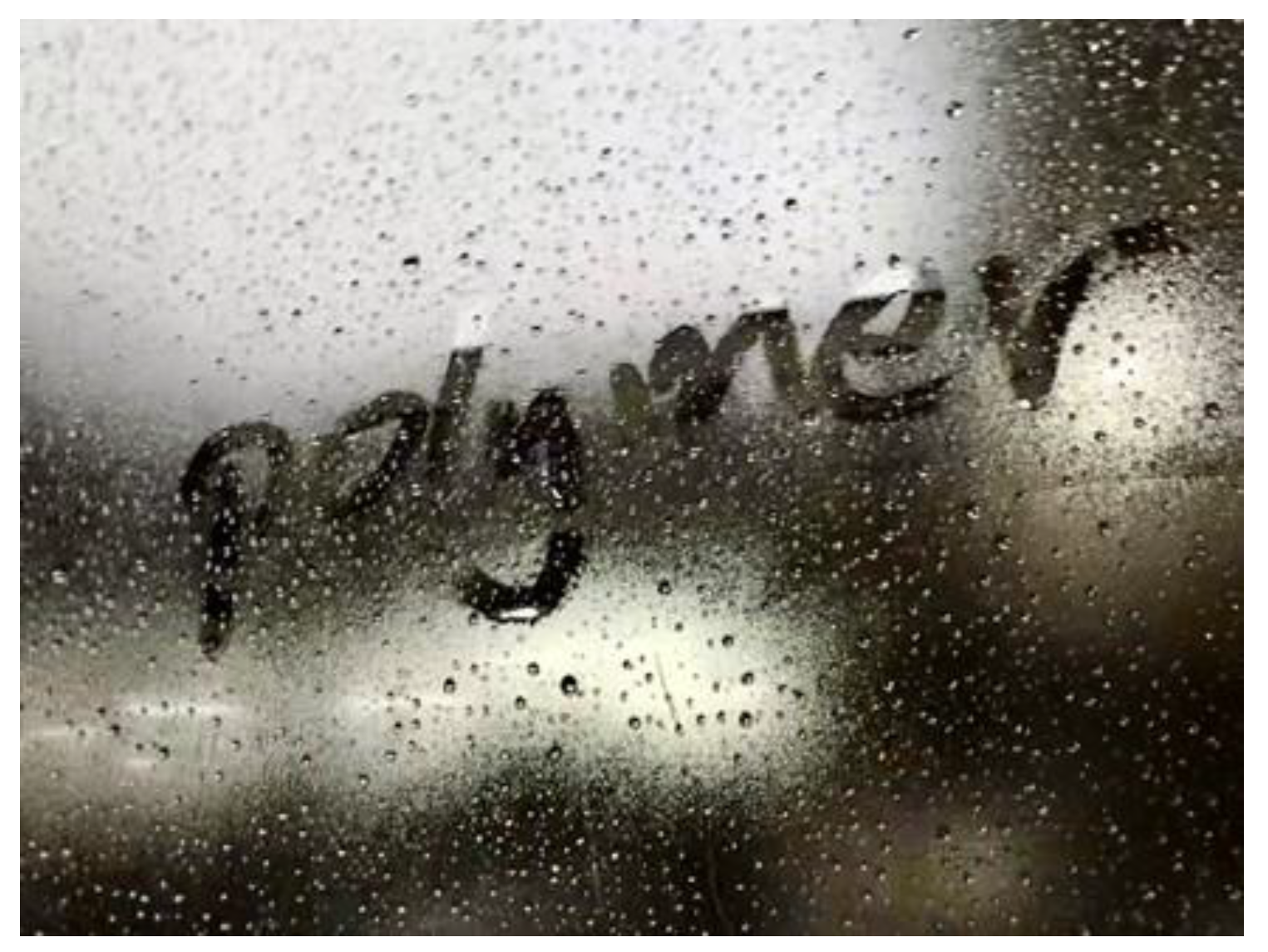
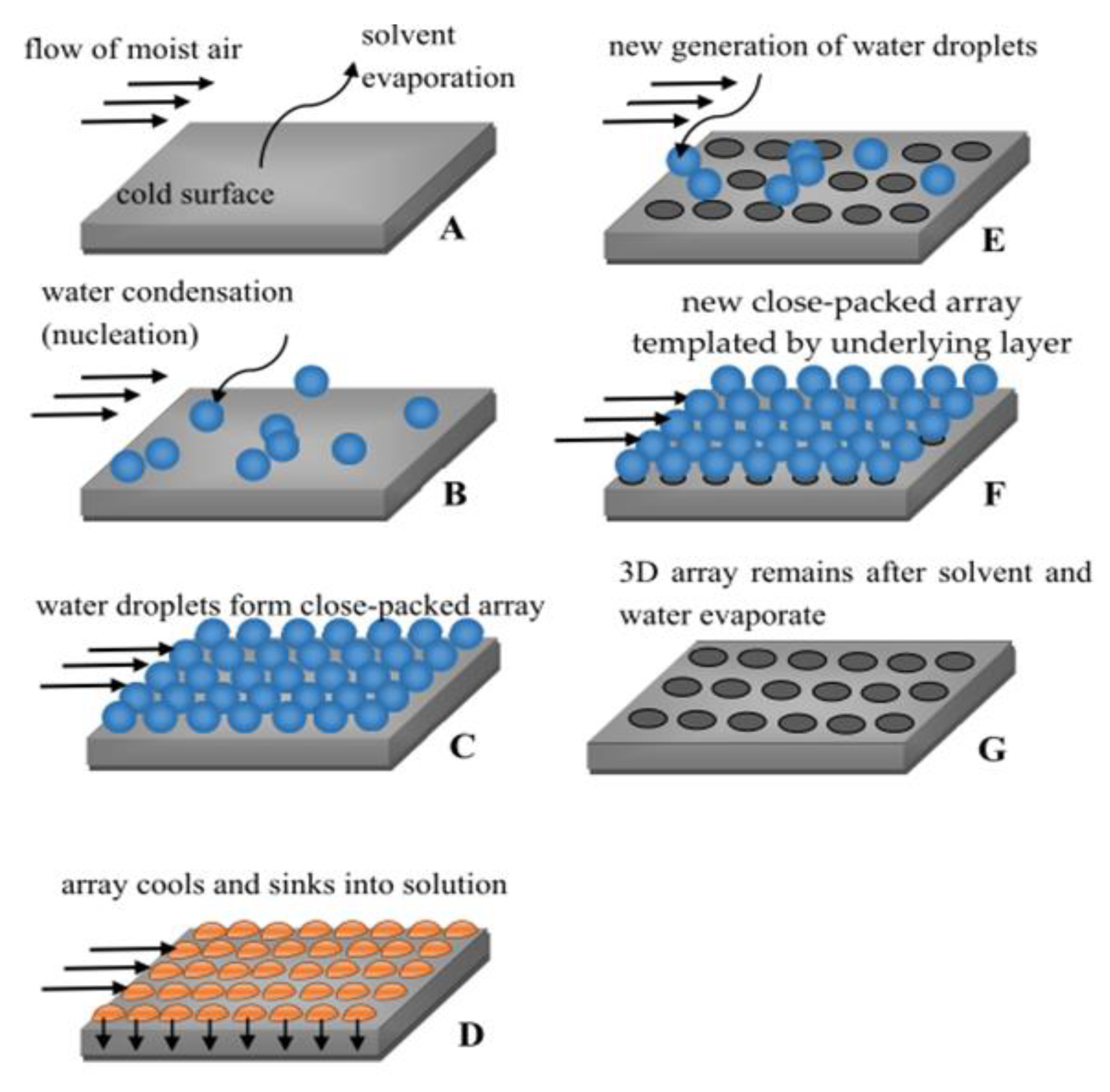



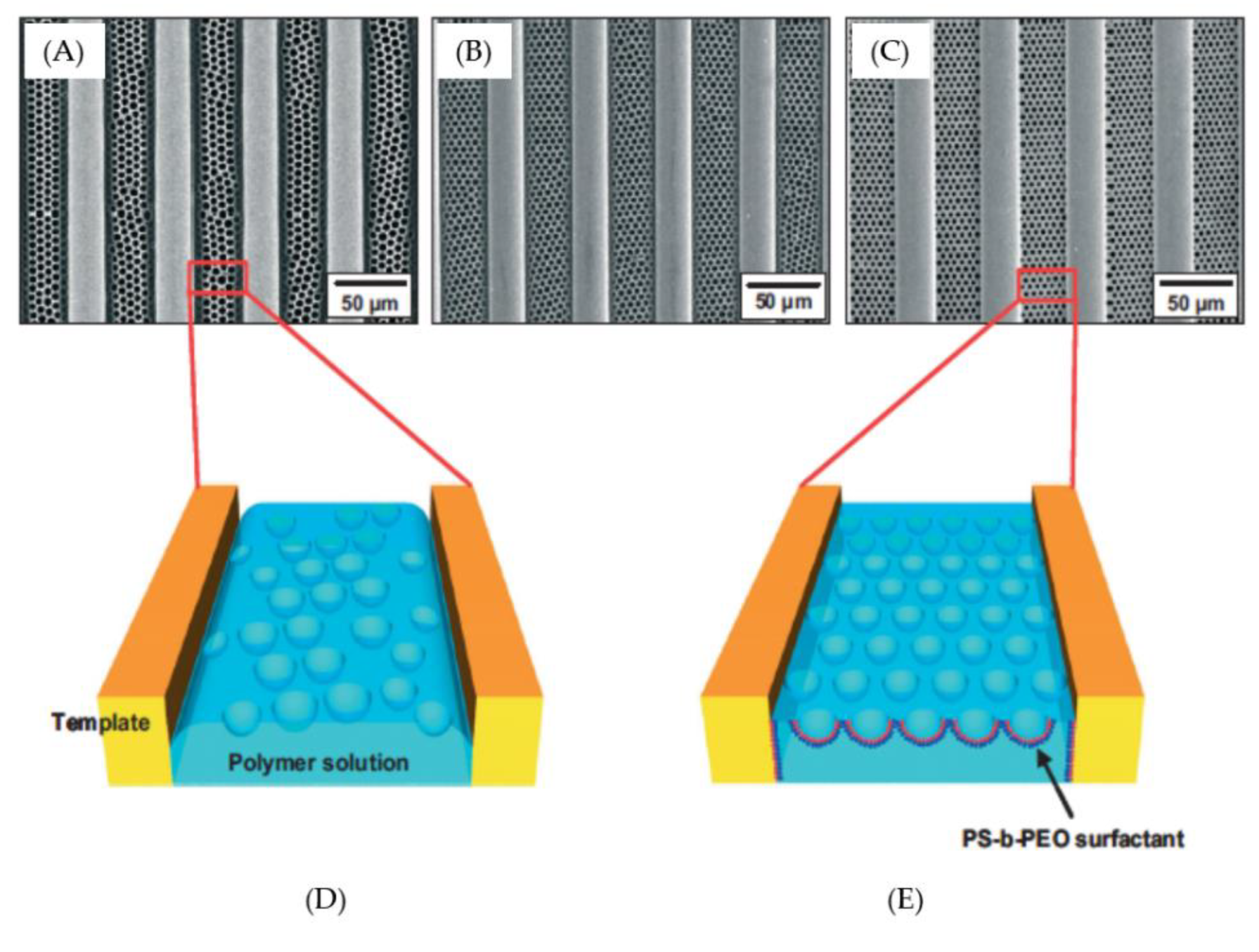



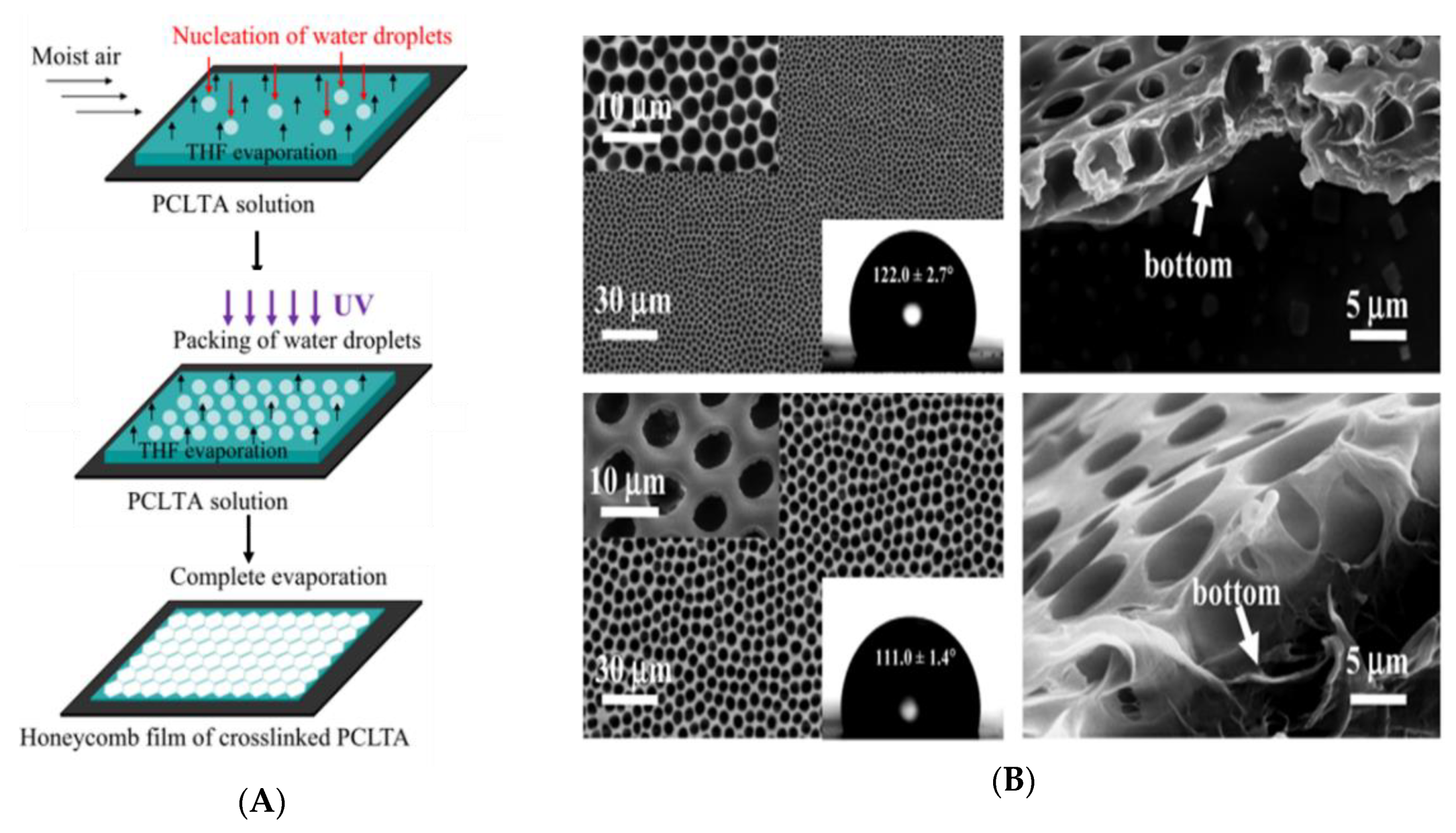
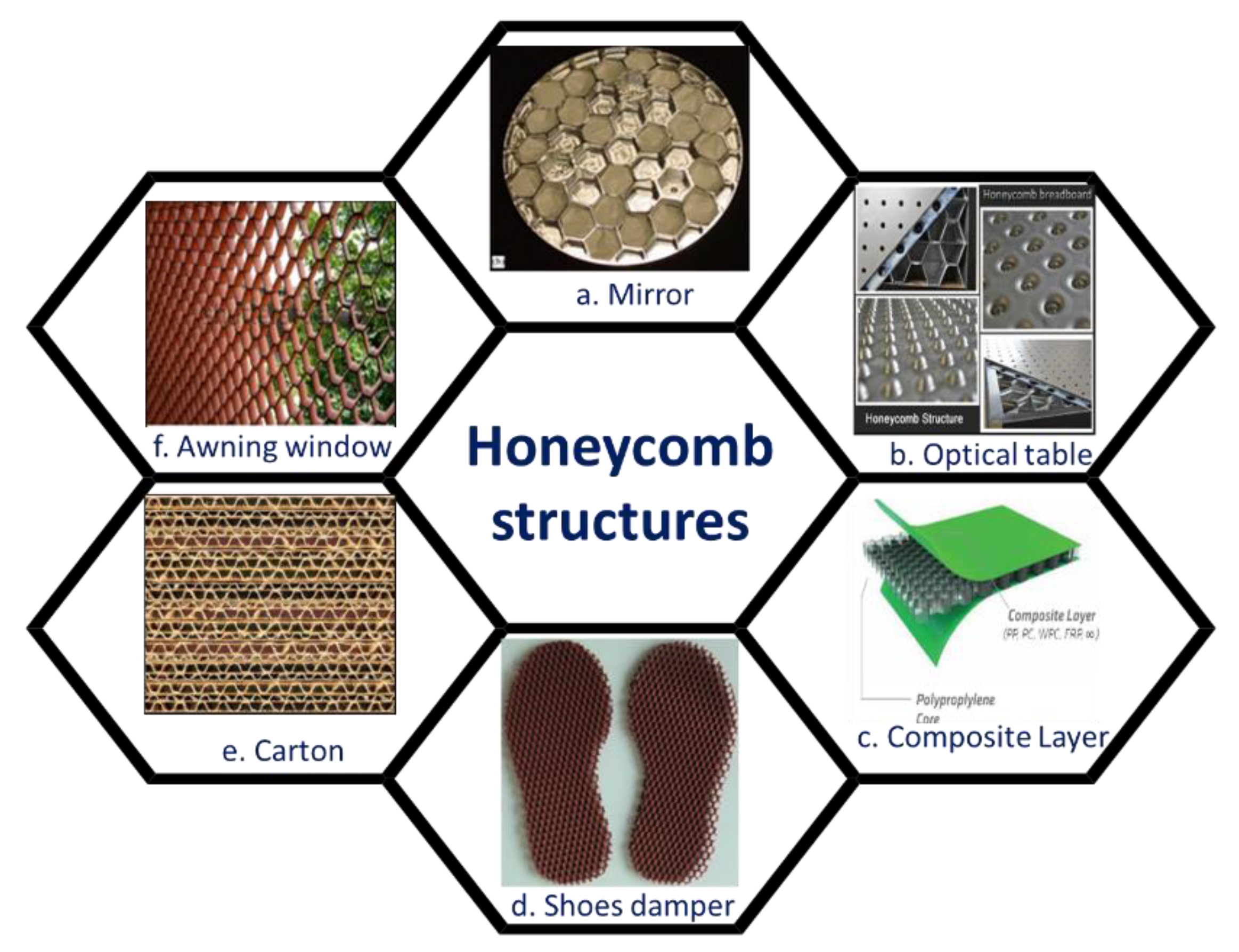


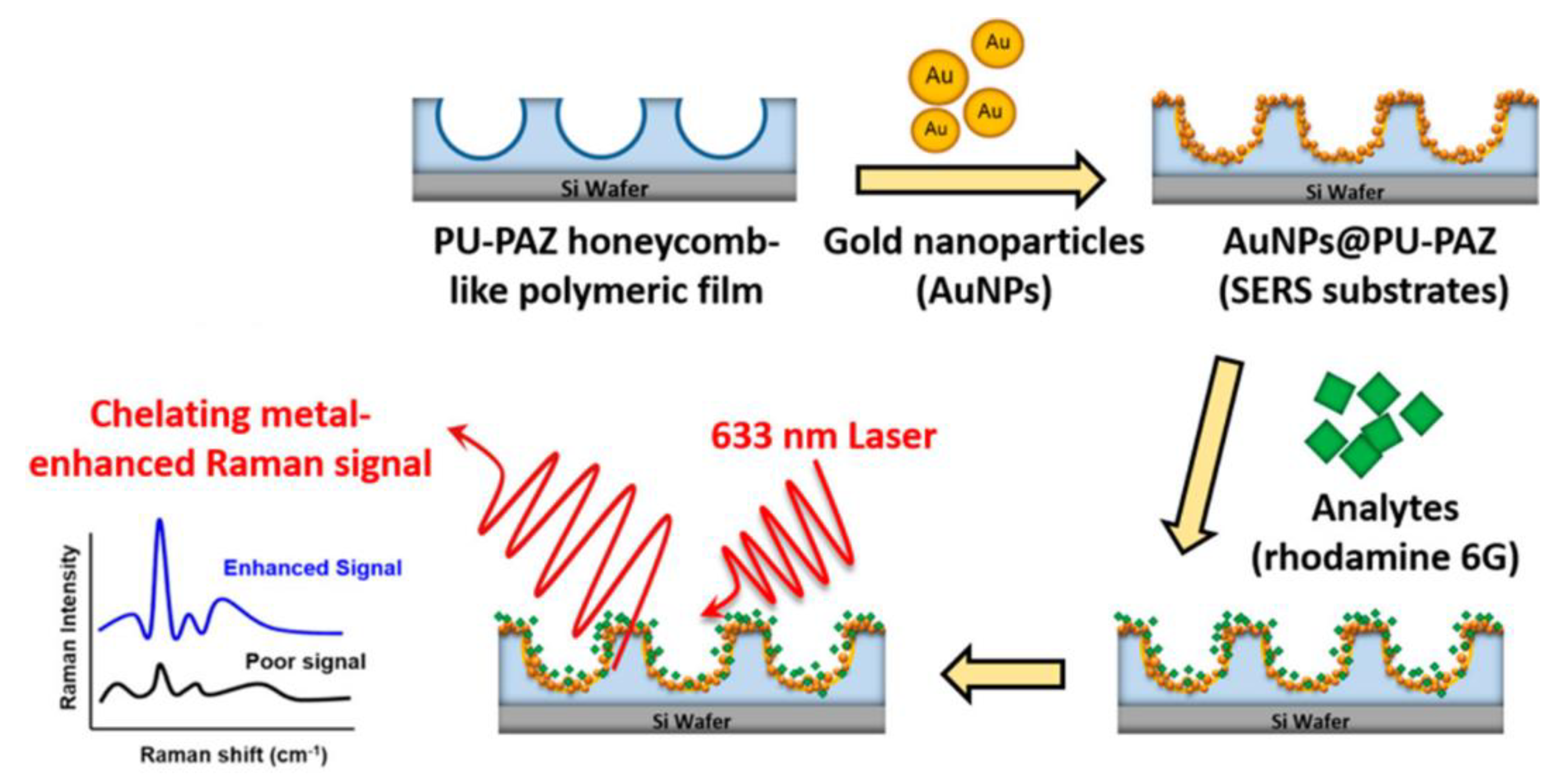
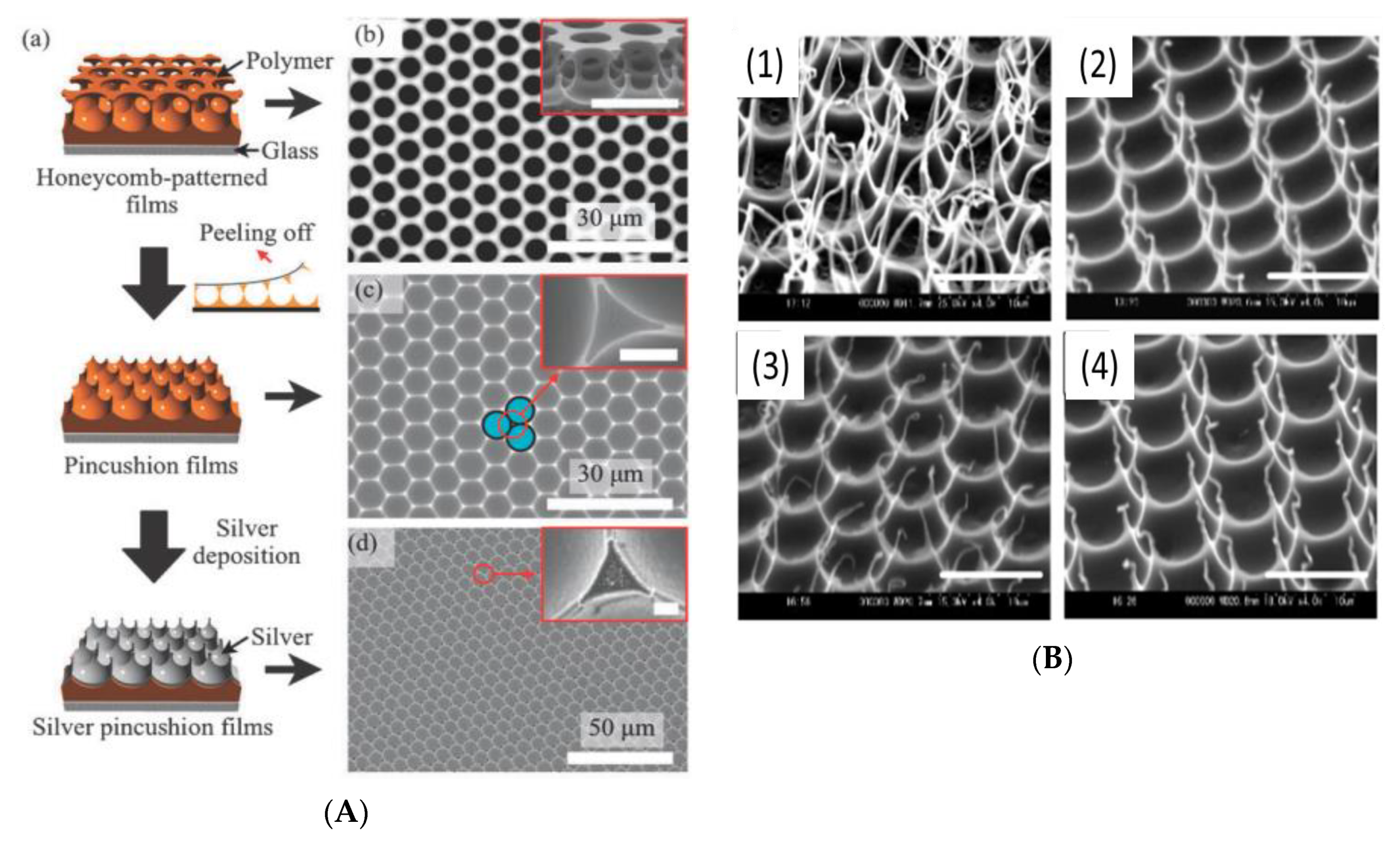
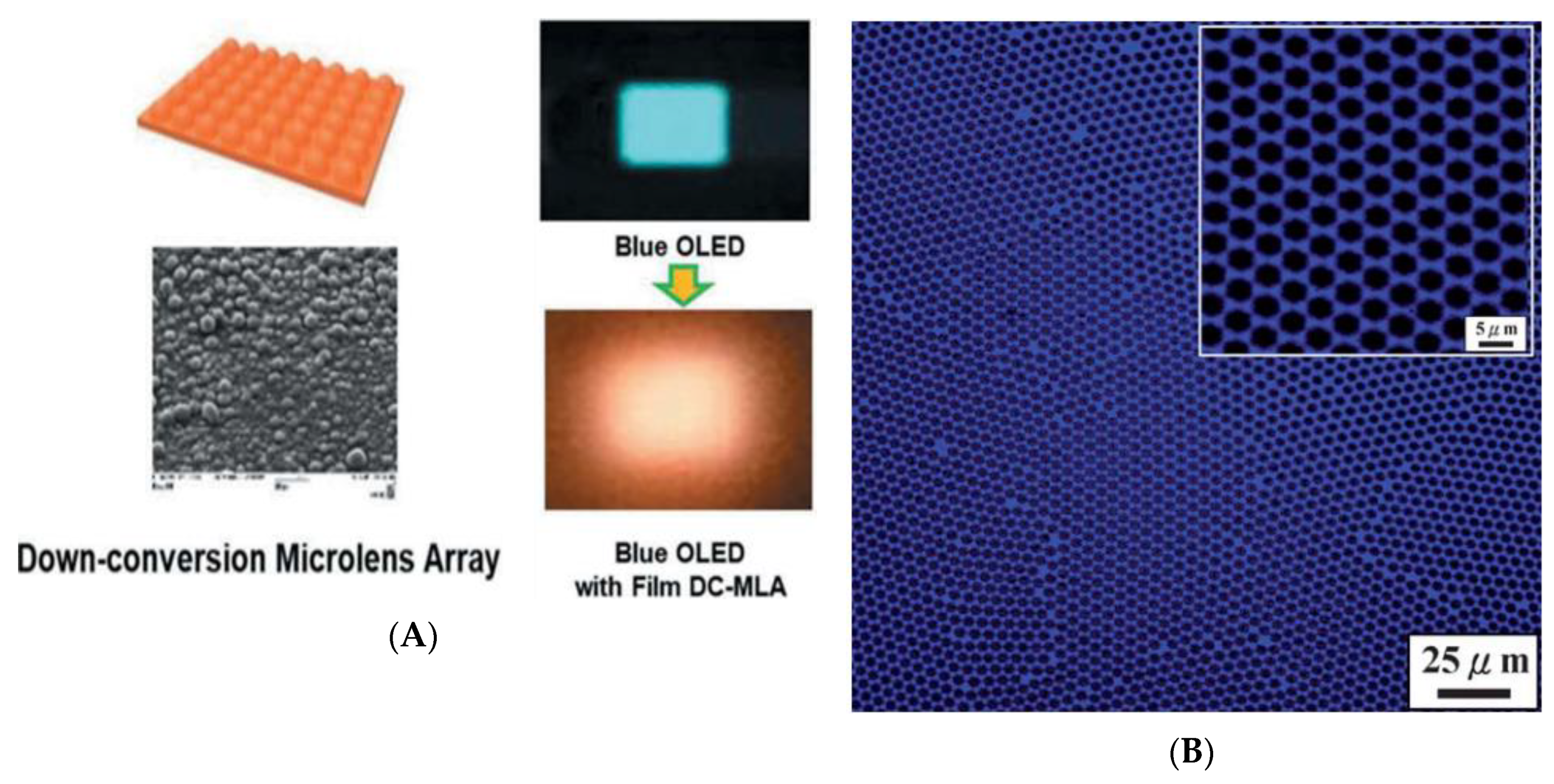

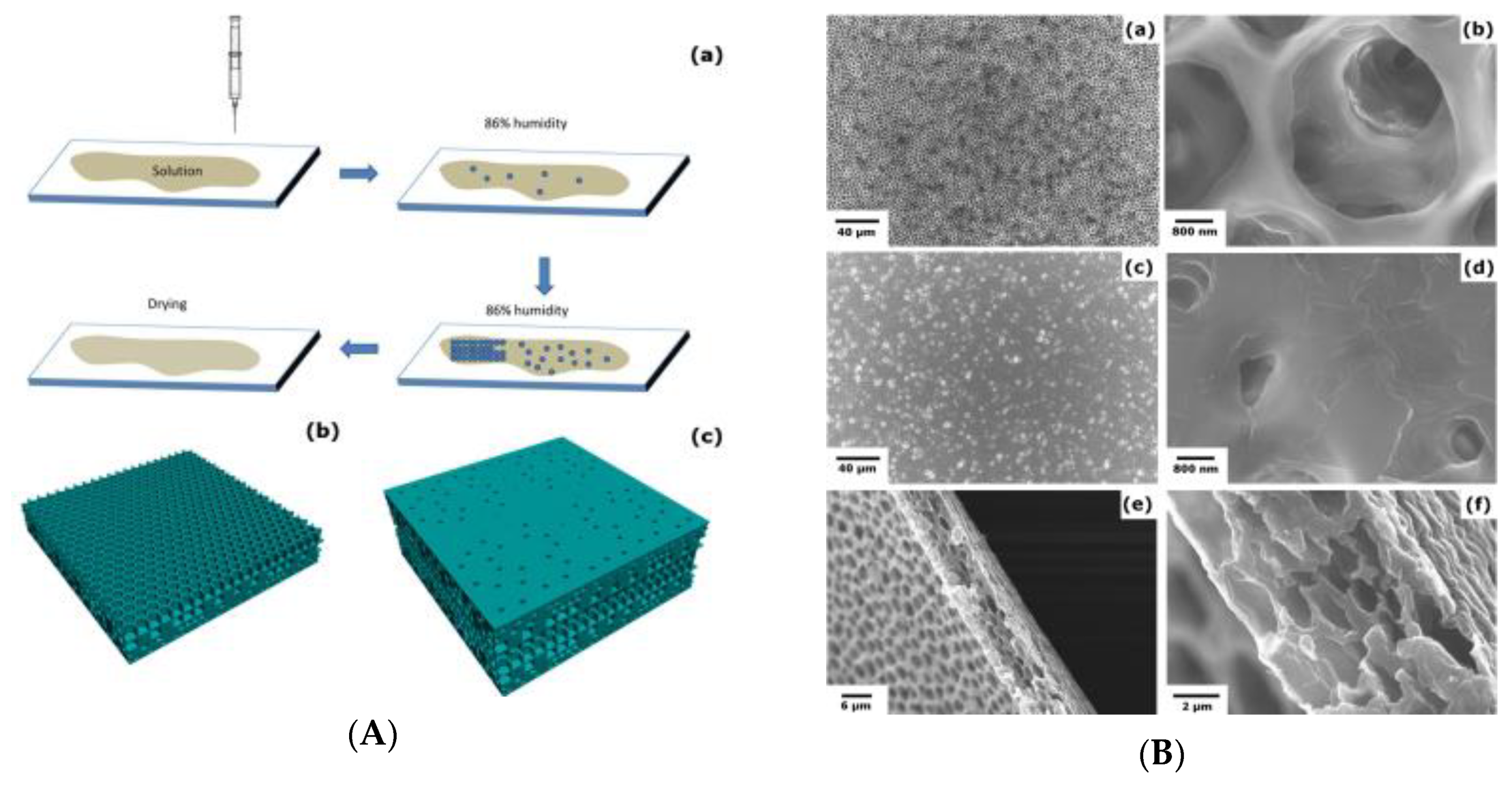
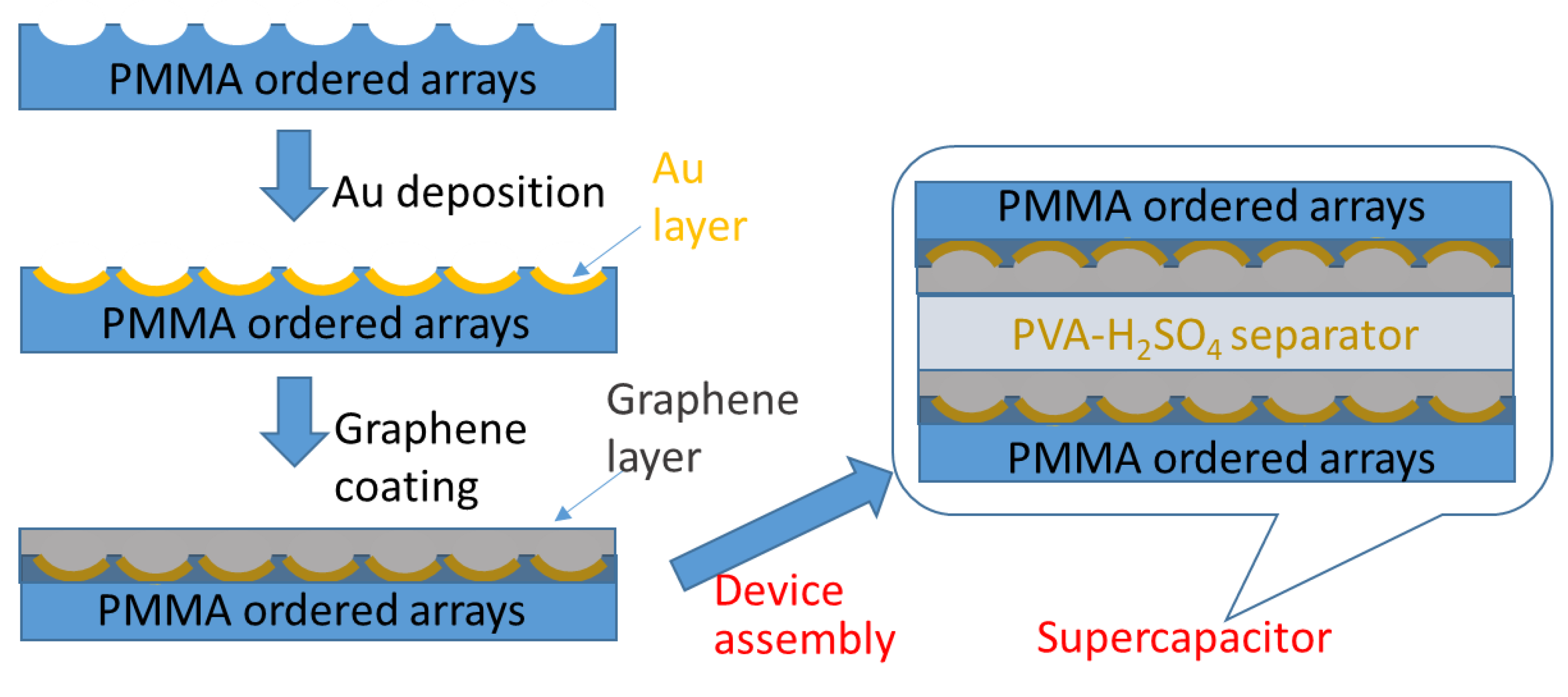
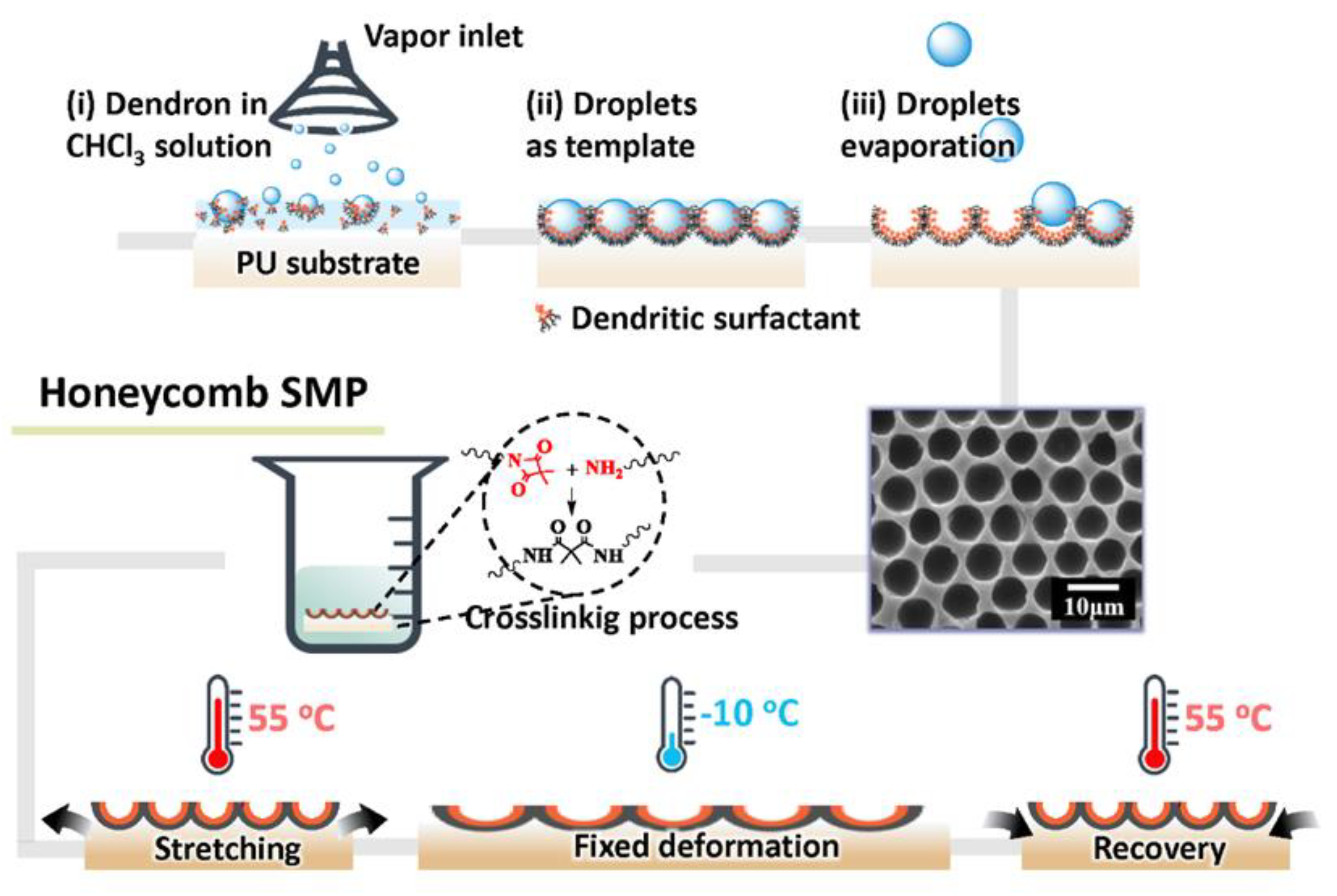

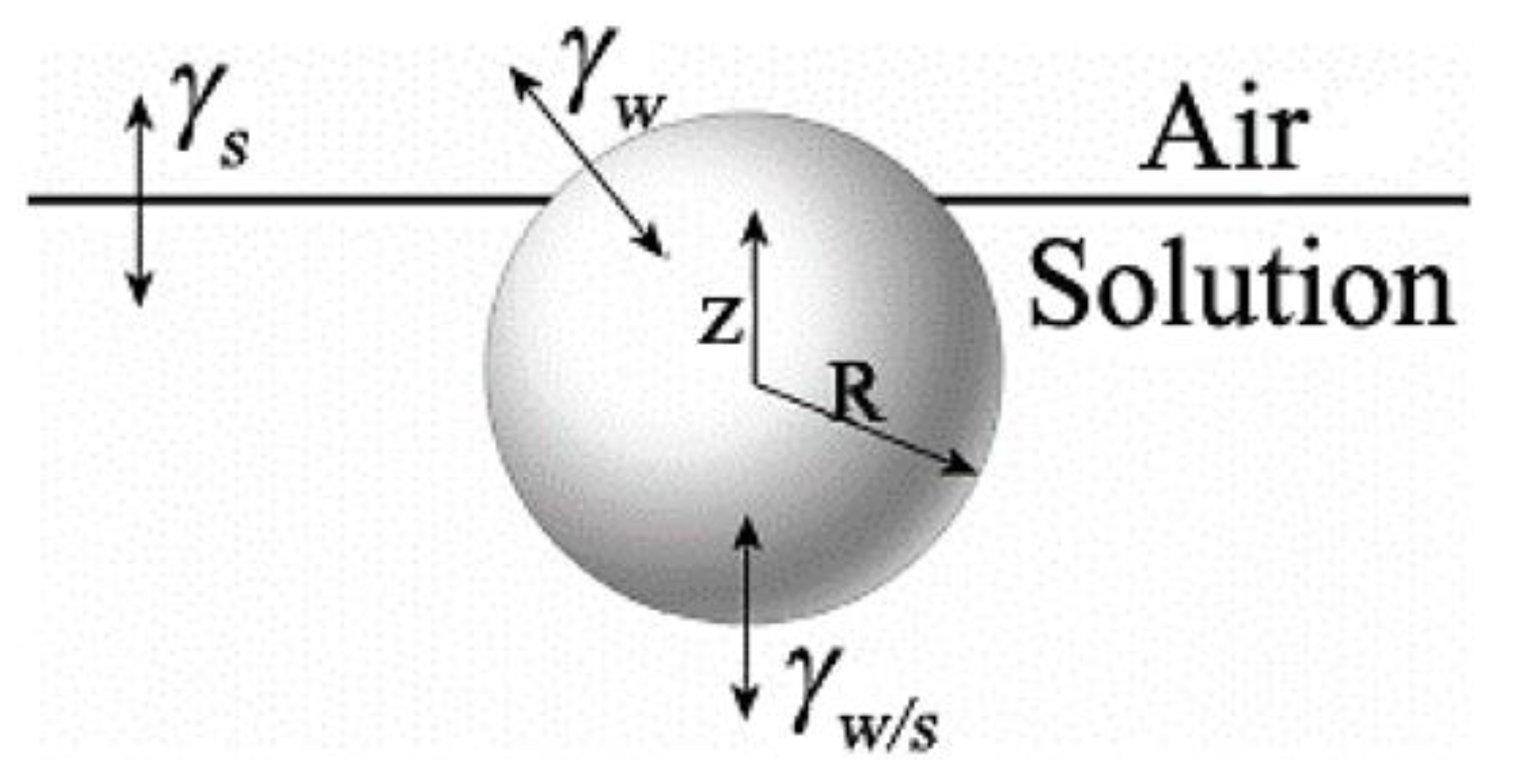

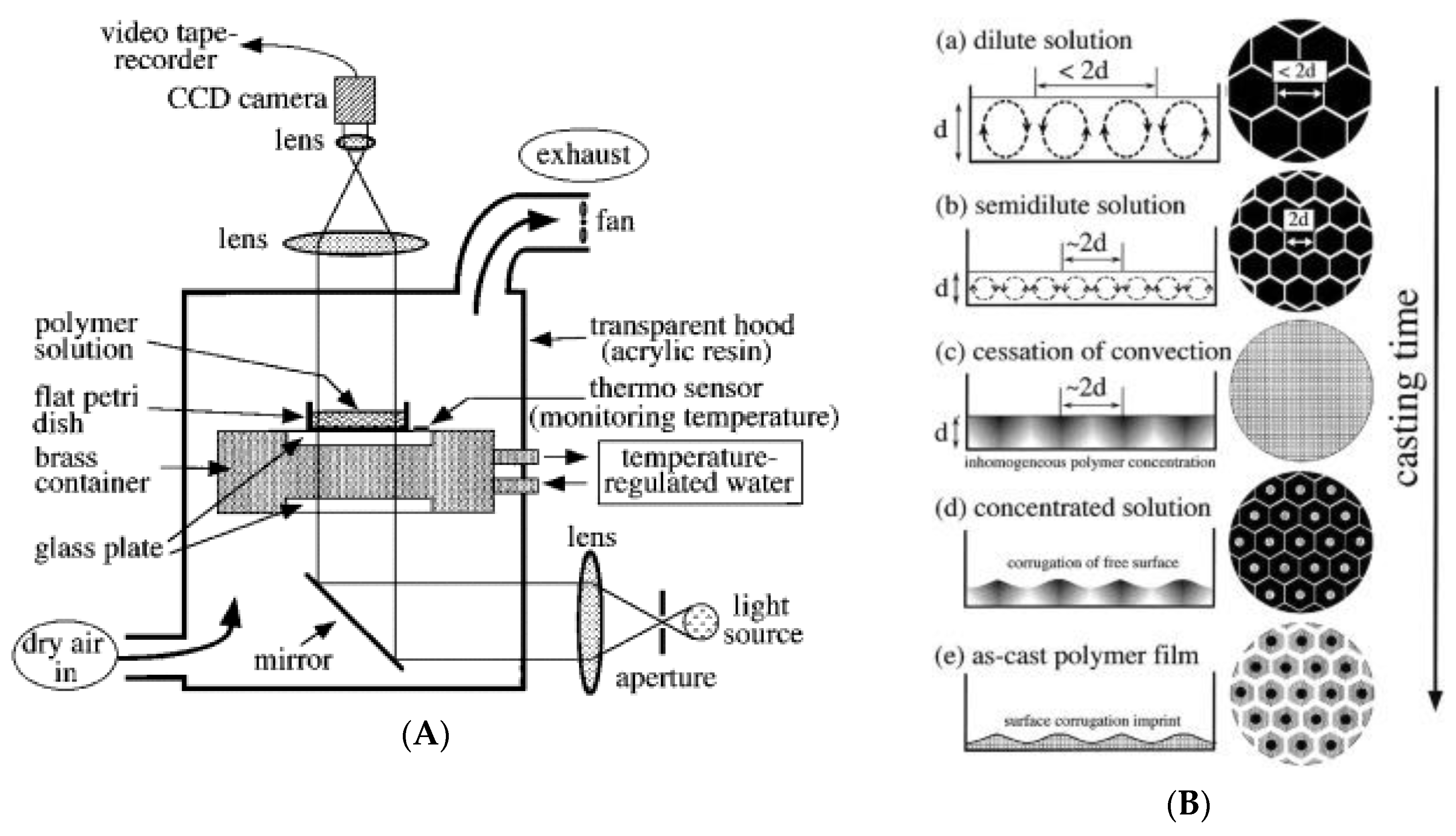

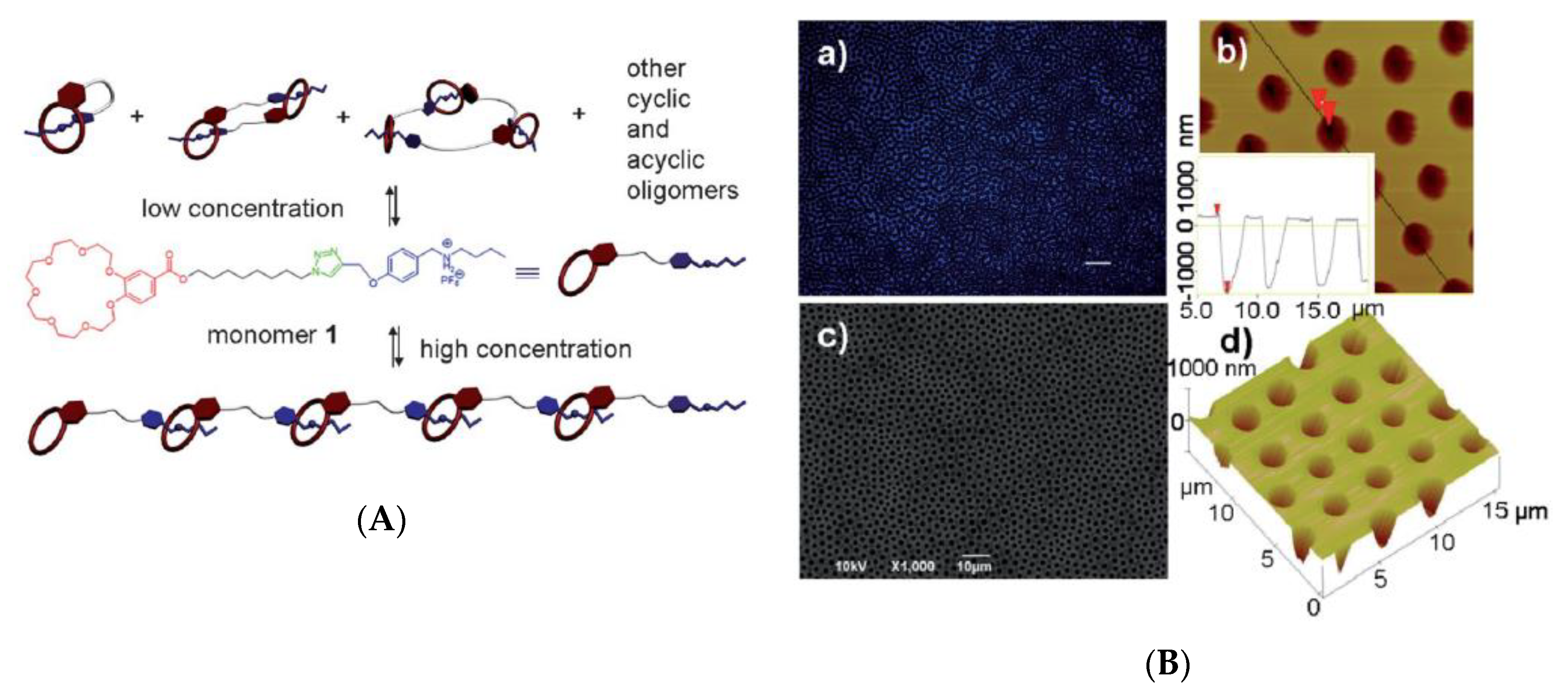

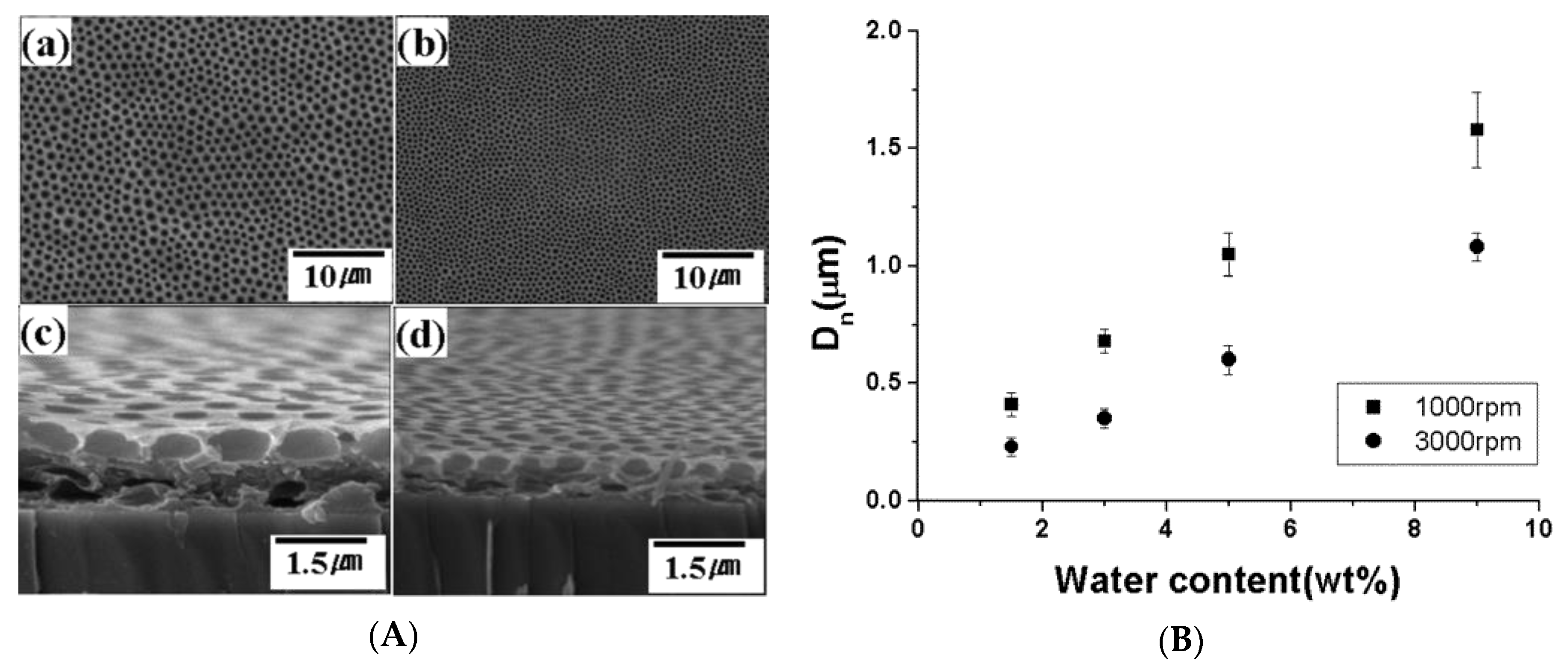
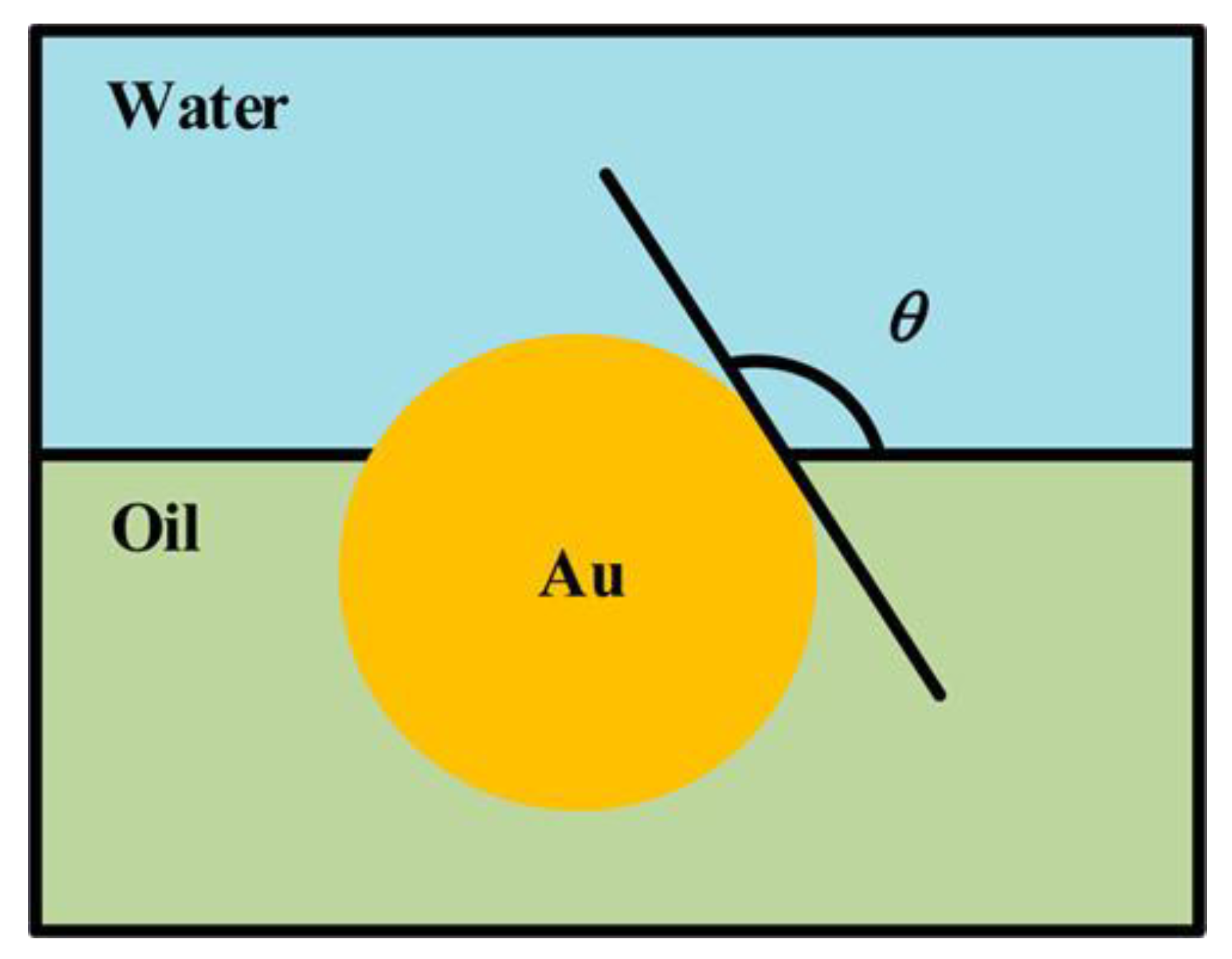
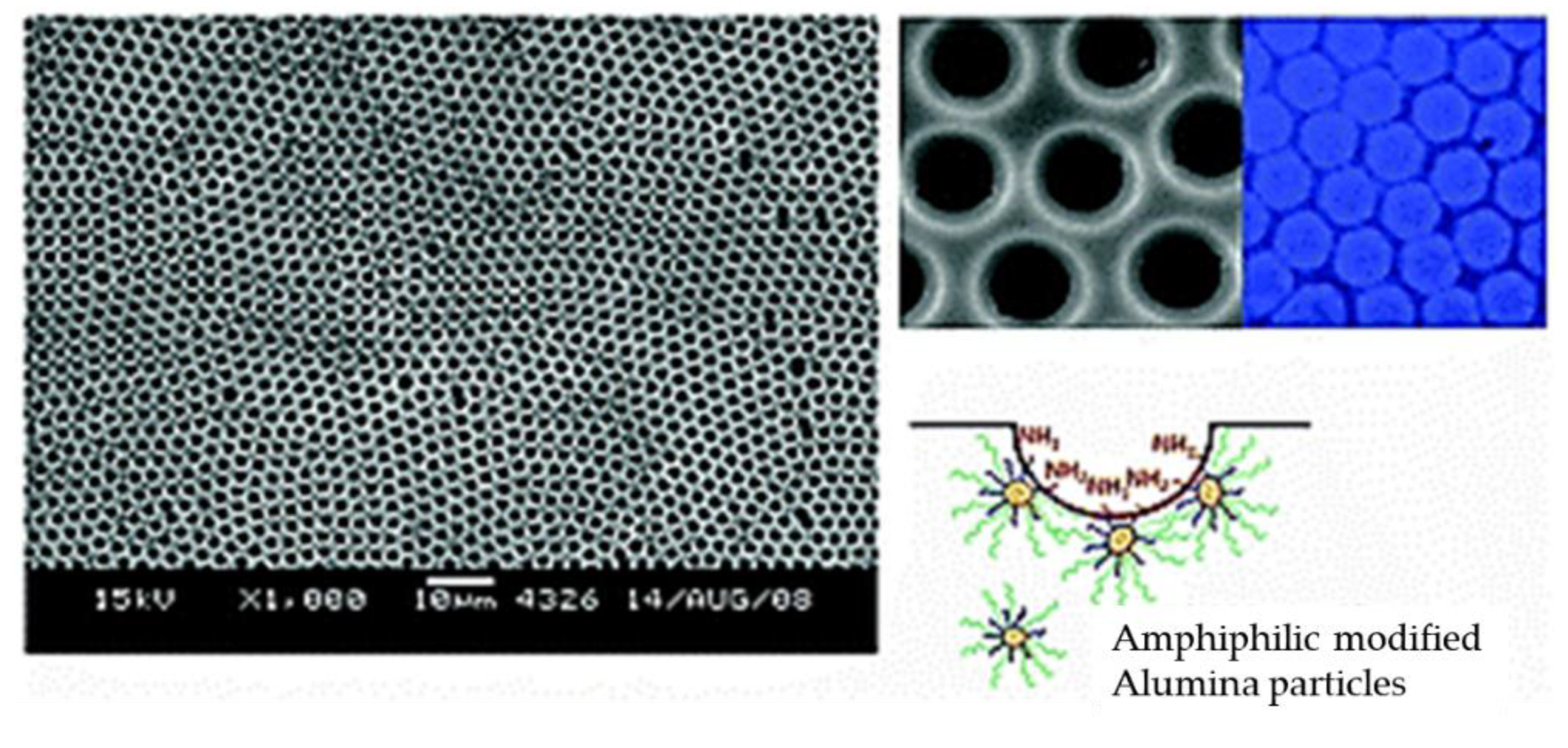
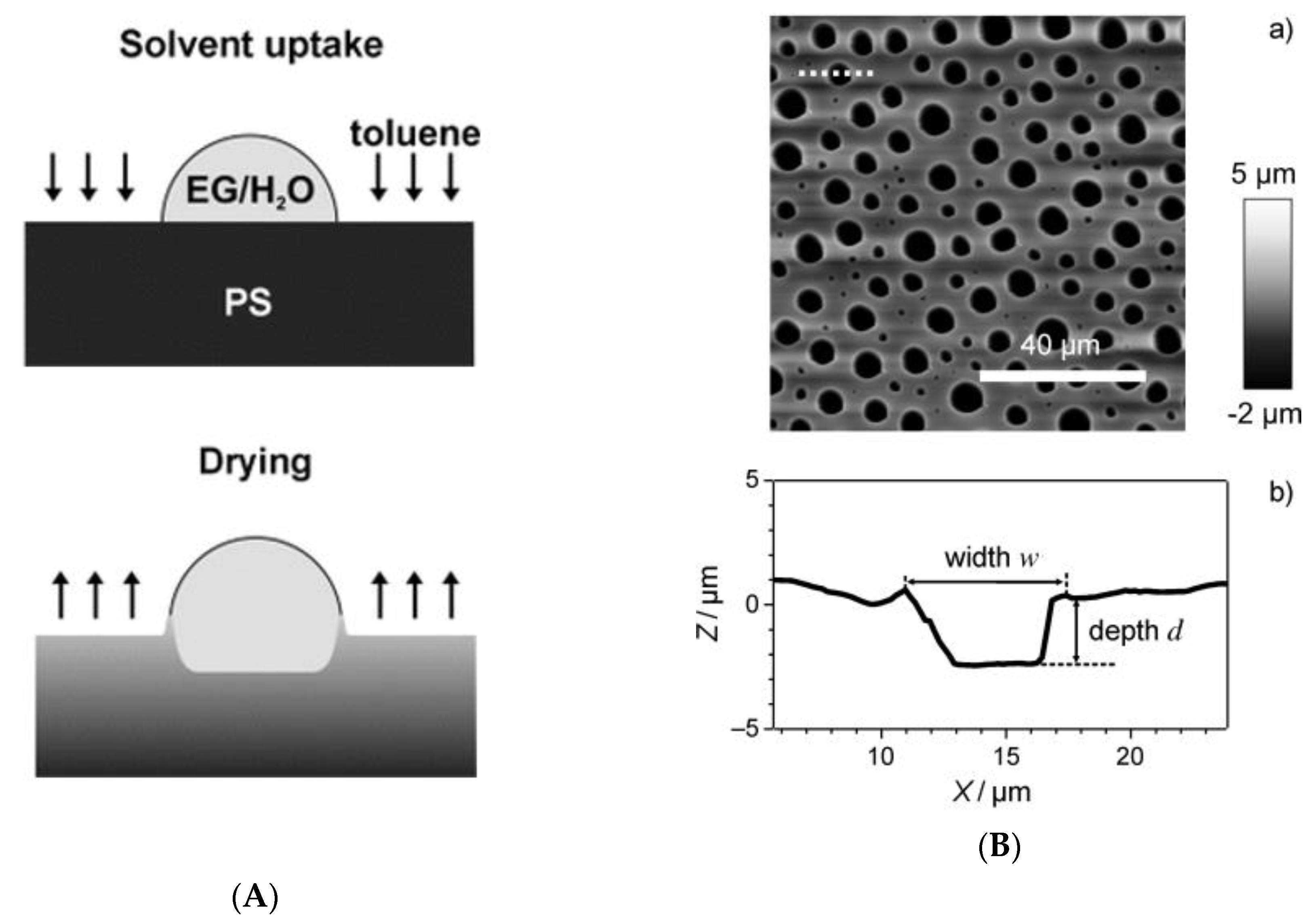
| Category | Solvents |
|---|---|
| Recommended | Water, alcohols (EtOH, i-PrOH, n-BuOH), ethyl acetate (EtOAc; EA), isopropyl acetate (i-PrOAc), butyl acetate (n-BuOAc), anisole, sulfolane. |
| Recommended or problematic? | MeOH, tert-butyl alcohol (t-BuOH), benzyl alcohol, ethylene glycol (EG), acetone, methyl ethyl ketone (MEK), methyl isobutyl ketone (MIBK), cyclohexanone, methyl acetate (MeOAc), acetic acid (AcOH), acetic anhydride (Ac2O). |
| Problematic | 2Me-THF, heptane, Me-cyclohexane, toluene, xylenes, chlorobenzene, acetonitrile, N,N′-dimethylpropyleneurea (DMPU), dimethyl sulfoxide (DMSO). |
| Problematic or hazardous? | Methyl tert-butyl ether (MTBE), THF, cyclohexane, dichloromethane (DCM), formic acid, pyridine |
| Hazardous | Diisopropyl ether, 1,4-dioxane, dimethyl ether (DME), pentane, hexane, N,N′-dimethylformamide (DMF), N,N′-dimethylacetamide (DMAc), N-methyl-2-pyrrolidone (NMP), methoxy-ethanol, triethylamine (TEA). |
| Highly hazardous | Diethyl ether, benzene, chloroform, tetrachloromethane (CCl4), 1,2-dichloroethane (DCE), nitromethane, carbon disulfide (CS2), hexamethylphosphoramide (HMPA) |
© 2019 by the authors. Licensee MDPI, Basel, Switzerland. This article is an open access article distributed under the terms and conditions of the Creative Commons Attribution (CC BY) license (http://creativecommons.org/licenses/by/4.0/).
Share and Cite
Yeh, S.-C.; Wu, C.-H.; Huang, Y.-C.; Lee, J.-Y.; Jeng, R.-J. In Search of a Green Process: Polymeric Films with Ordered Arrays via a Water Droplet Technique. Polymers 2019, 11, 1473. https://doi.org/10.3390/polym11091473
Yeh S-C, Wu C-H, Huang Y-C, Lee J-Y, Jeng R-J. In Search of a Green Process: Polymeric Films with Ordered Arrays via a Water Droplet Technique. Polymers. 2019; 11(9):1473. https://doi.org/10.3390/polym11091473
Chicago/Turabian StyleYeh, Shih-Chieh, Chien-Hsin Wu, Ying-Chih Huang, Jen-Yu Lee, and Ru-Jong Jeng. 2019. "In Search of a Green Process: Polymeric Films with Ordered Arrays via a Water Droplet Technique" Polymers 11, no. 9: 1473. https://doi.org/10.3390/polym11091473
APA StyleYeh, S.-C., Wu, C.-H., Huang, Y.-C., Lee, J.-Y., & Jeng, R.-J. (2019). In Search of a Green Process: Polymeric Films with Ordered Arrays via a Water Droplet Technique. Polymers, 11(9), 1473. https://doi.org/10.3390/polym11091473







